1lumen selects and reviews products personally. We may earn affiliate commissions through our links, which help support our testing.
Lumintop GT4695 review
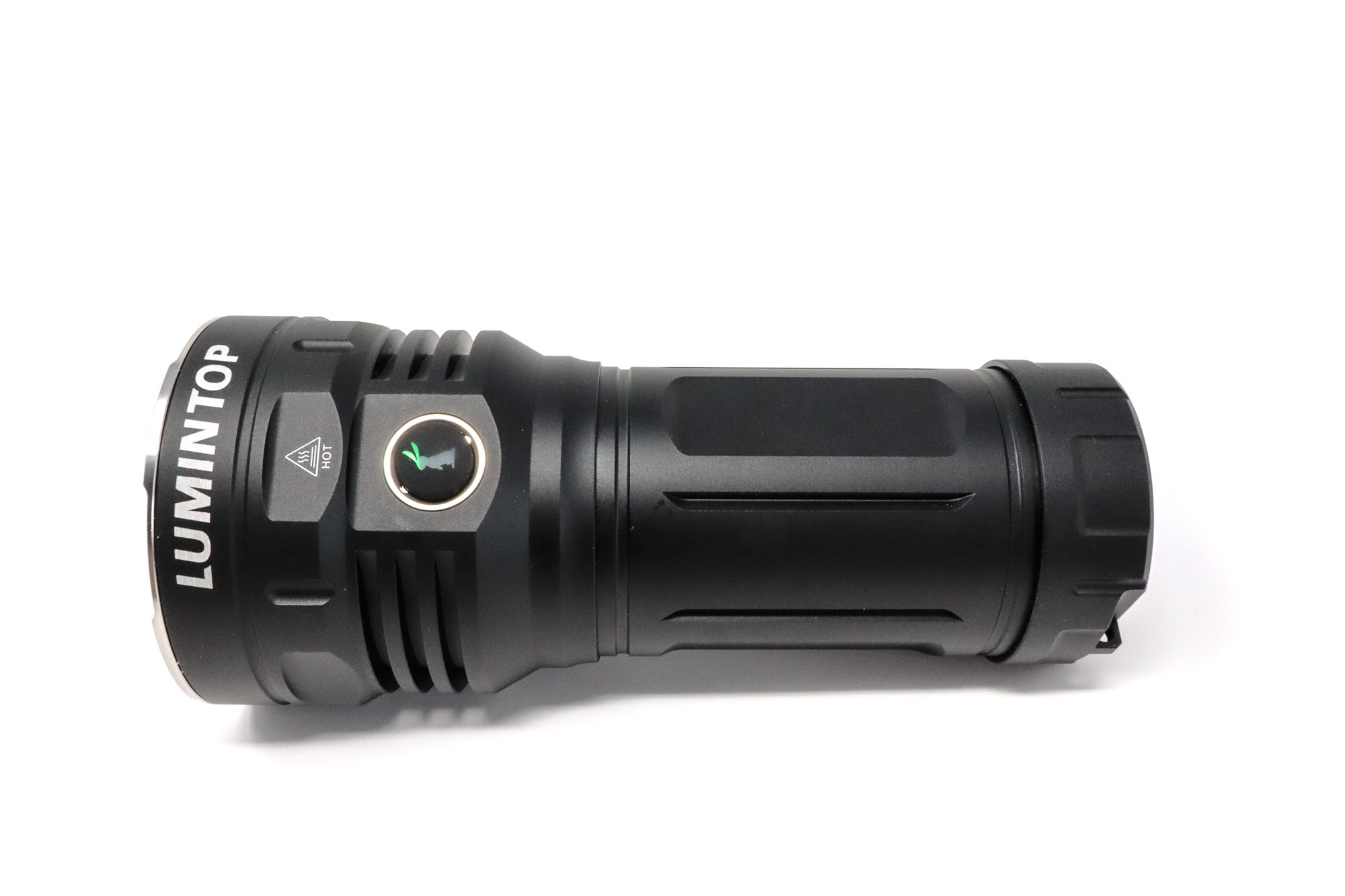
Lumintop GT4695 specifications
| Brand & Model | Lumintop GT4695 |
|---|---|
| Flashlight category | High output Thrower |
| LED | 1*SFP55 |
| Max. output | 15,000 lumens |
| Max. beam distance | 800 meters |
| Max. beam intensity | 160,000 cd |
| Battery config. | 1*46950 |
| Onboard charging | USB type C |
| Main modes | 4 |
| Blinkies | Strobe, SOS, Beacon |
| Waterproof | IP68 |
| Review publication date | March 2024 |
Review intro:
A while back, Gabriel reviewed a new light from Lumintop, the Rattlesnake. It was a 2×21700 thrower with a new, big LED from the mysterious Chinese LED manufacturer San’an Optoelectronics. It was called the SFP55, and enabled the Rattlesnake to reach over 15,000 Lumens (for a second), making it the brightest single LED flashlight on earth at turn on.
5 years ago, this performance was unheard of from a pocketable flashlight. Well, we know the nomenclature of bigger is better and Lumintop applied this to the light on my desk for review today (a big thanks to Banggood for sending this one out). This new light isn’t exactly a replacement for the Rattlesnake, but it’s sure an upgrade.
This light is the GT4695. The ‘4695’ should be a clue for some attentive readers, but the SFP55 LED is back, the big reflector is here, and they’re joined by a big battery, promising big specs. I’m dubious of Lumintop’s specs on lights like this, but hey, I’ve been surprised before. Read on for more!
What’s in the package
The GT4695 borrows the package from their own Mach: An elegant black on black box with a magnetic flap. It’s very nice. Inside the GT4695 sits in cut foam with some accessories and goodies. Here’s what’s inside:
- Lumintop GT4695
- Lumintop branded 32,000 mAh 46950 battery (integrated)
- Instruction guide
- O-ring
- Lanyard
- USB C charging cable
This is a ready to run kit. The battery was installed in the light and had an isolator between the driver and battery. Remove the lens protection film and you’re ready to go…almost. The cell was sitting at 3.6 volts, so it needed to be fully charged. It’s usable out of the box, but full output is not available.
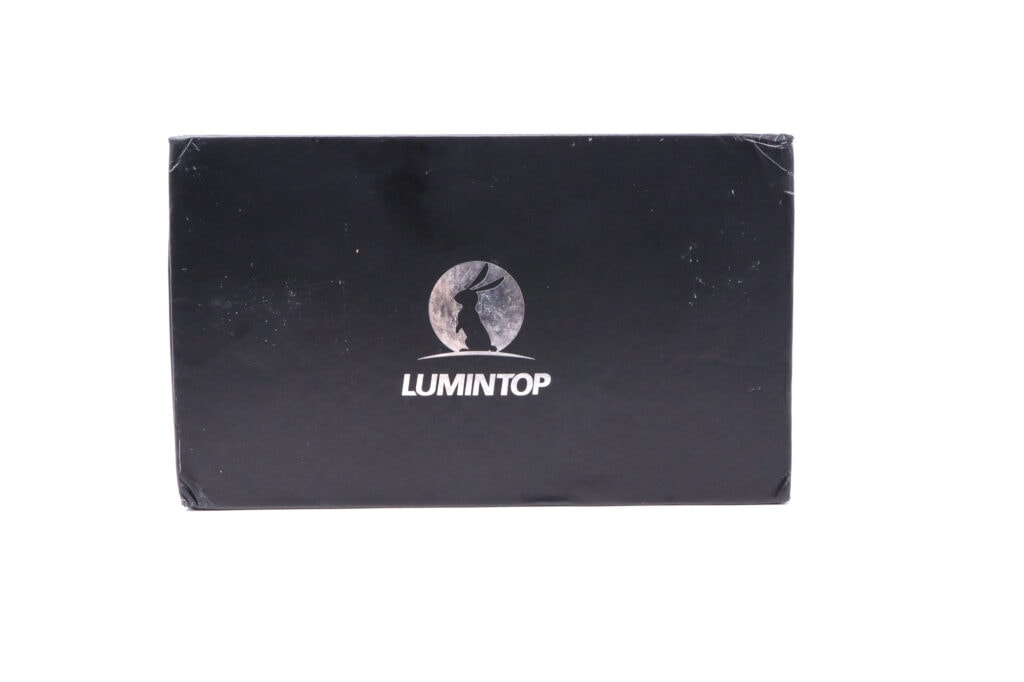
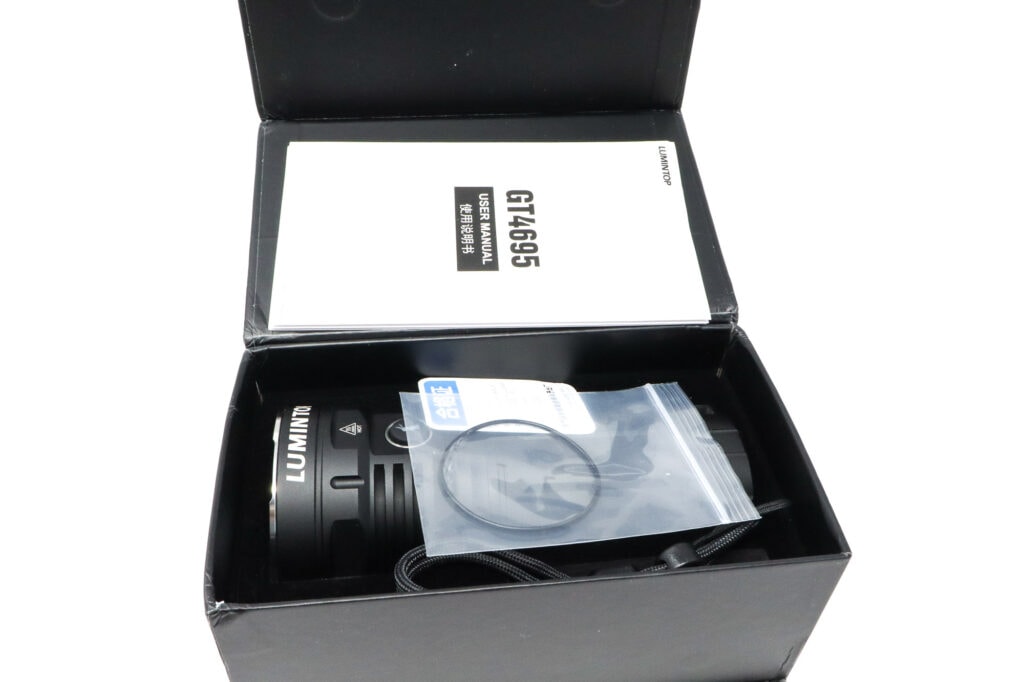
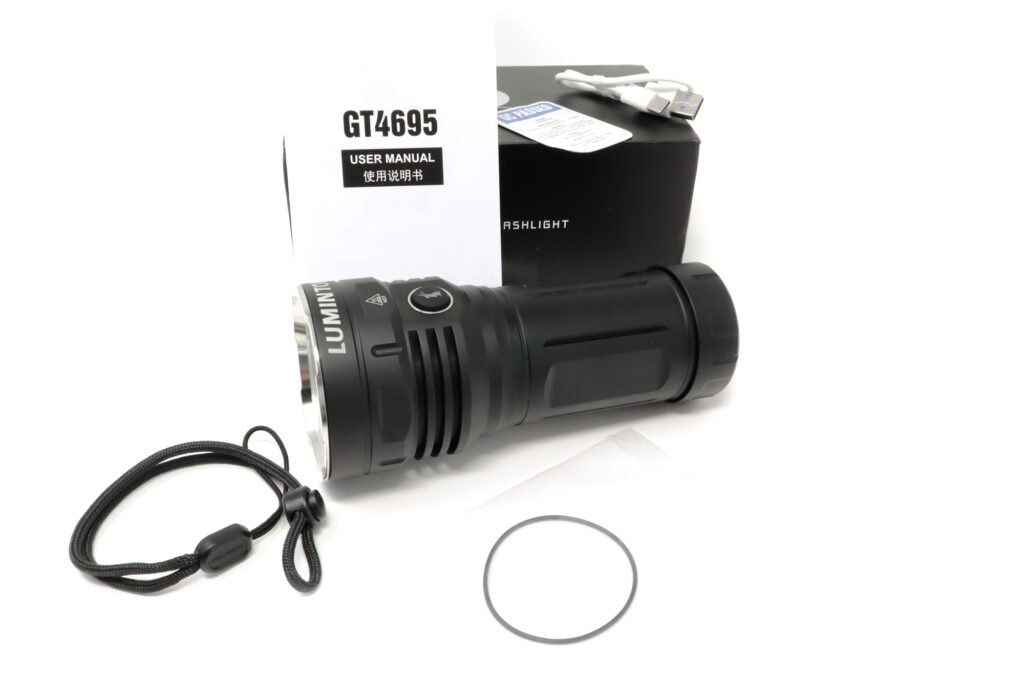
Flashlight in use, Build Quality, and Warranty
The Lumintop GT4695 is a high output general purpose flashlight. It can make a lot of light and spread it out over a large area with lots of beam distance. These types of lights are usually sporting multiple batteries, and are bulky, and heavy. This light follows that, so you’ll be toting the GT4695 around on the lanyard or in an appropriate holster (not included).
I was surprised not to see a threaded mount on this one since I do think a holster would be the best method for carry, but you need one that can accommodate a longer flashlight. Unlike the Machs, there’s now a lanyard mount on the tailcap, and yes, I could thread the lanyard without using a tool. Thanks Lumintop! The hole is big enough to accommodate a quick release clasp for a single point harness if that’s your thing.
The form factor is instantly recognizable as the soda or soup can style. These are short, chubby lights with large-diameter bodies. The battery tube doesn’t have knurling or texturing, but does have an angular profile to aid in gripping. That said, I’d say this is a less-grippy surface versus the Machs. The tube is wide, and while my big meat mitts didn’t have trouble handling it, I’d imagine folks with smaller hands might.
Switching duties are handled by a single e-switch aft of the head. The rubber button has a translucent Lumintop bunny logo with LEDs behind it for on state charge status, and LVP. Opposite the switch is the USB C charge input/power bank output. It’s sealed with a good-size silicone rubber plug. The light has a mysterious screwed-in plug at the 3 o’clock position.
Build quality for the GT4695 is great. I didn’t notice any issues with ill-fitting parts and no anomalies with the finish. The light came with a lens protector film out of the box (I love peeling those off…satisfying). Overall, this is a well-built light, and in case you’re wondering, it will set you back about $149 US (Price at Banggood on date of publication) which isn’t at all unreasonable and on the fringe of what I consider a ‘budget light.’ The light is milled from the typical 6061-T6 aluminum alloy, and the machining is very tidy.
There’s no sharp edges anywhere either. The finish is black type III HA hard anodizing, and it’s also well done. It’s a nicely matte finish, and while not super-grippy, it feels nice in the hand. I tried unscrewing the bezel and the tailcap, but no-go on those. Either they’re glued or just on really tight. The head unscrews from the tube, and the top of the battery is visible, but I gave up trying to ‘liberate it’ from the tube short of digging out the tools, so either these parts are sealed or require extra ‘effort’ to open.
The back of the head has the same electrical connection as the Mach 4695, a single, thick spring with a top contact for the battery positive and a circular ground plane for battery negative. The threads for the tube are fully anodized, rectangular and smooth. It’s o-ring sealed also, and Lumintop gives the GT4695 an IP68 rating for 2 meters of immersion.
Lumintop’s warranty is good for a budget light: 30-day free replacement or repair for factory defects with a 5- year limited warranty for repairs required for problems associated with normal use. Products with built-in batteries are guaranteed for 2 years, and accessories are covered for 1 year. After the 5 year warranty, Lumintop will repair defective products for a fee. The warranty does not cover normal wear and tear, abuse, modifications, or intentional damage.
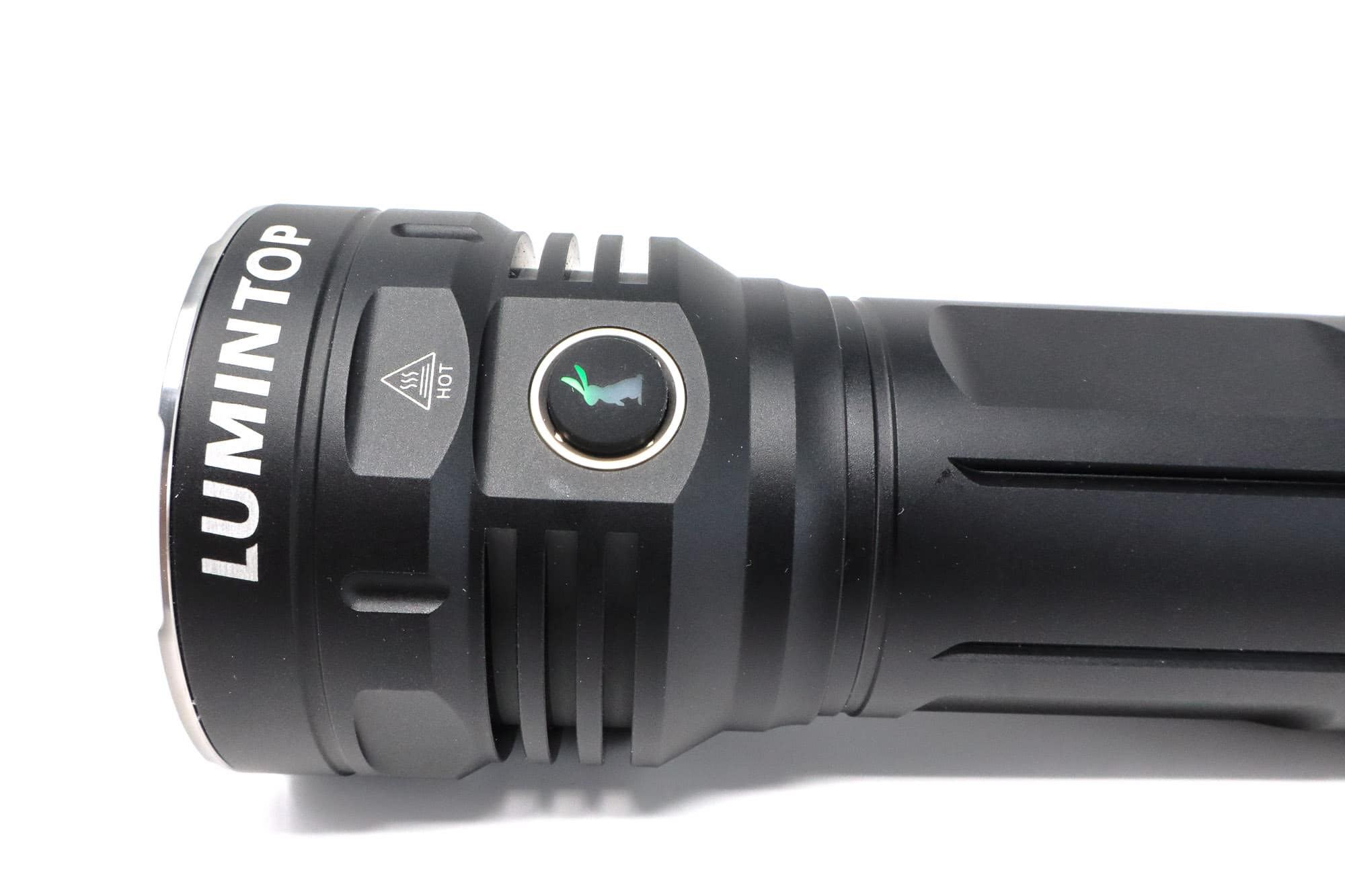
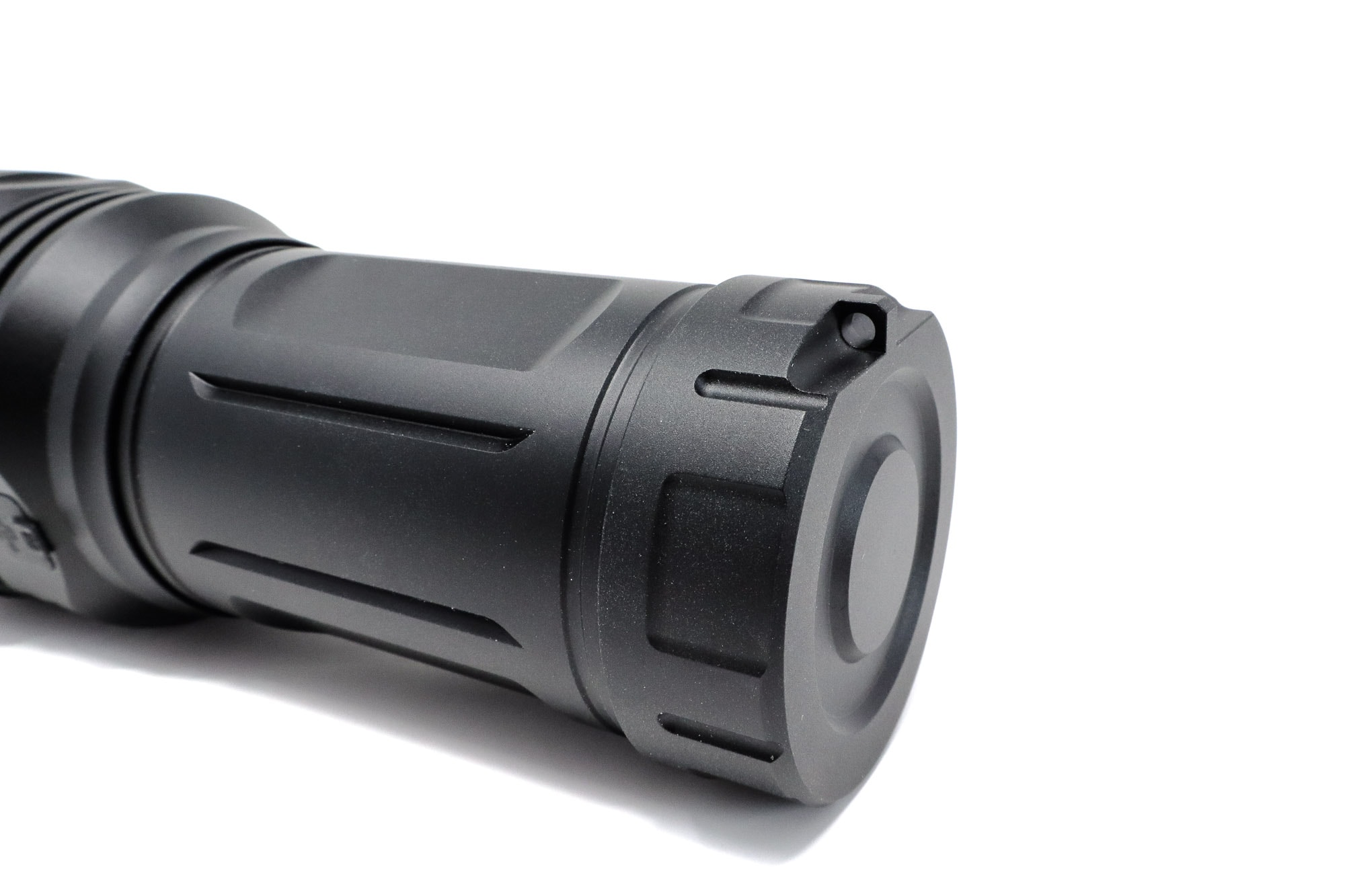
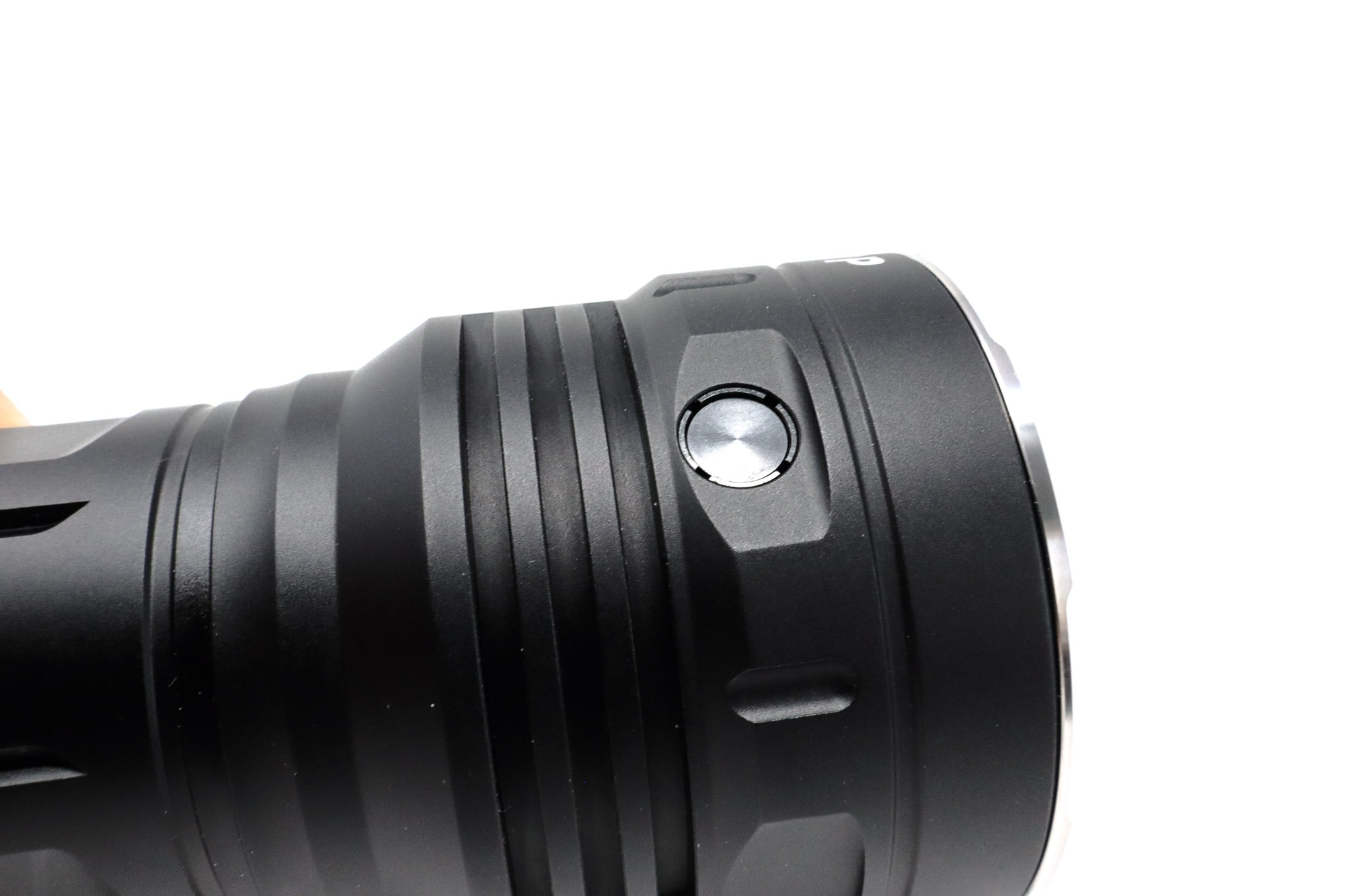
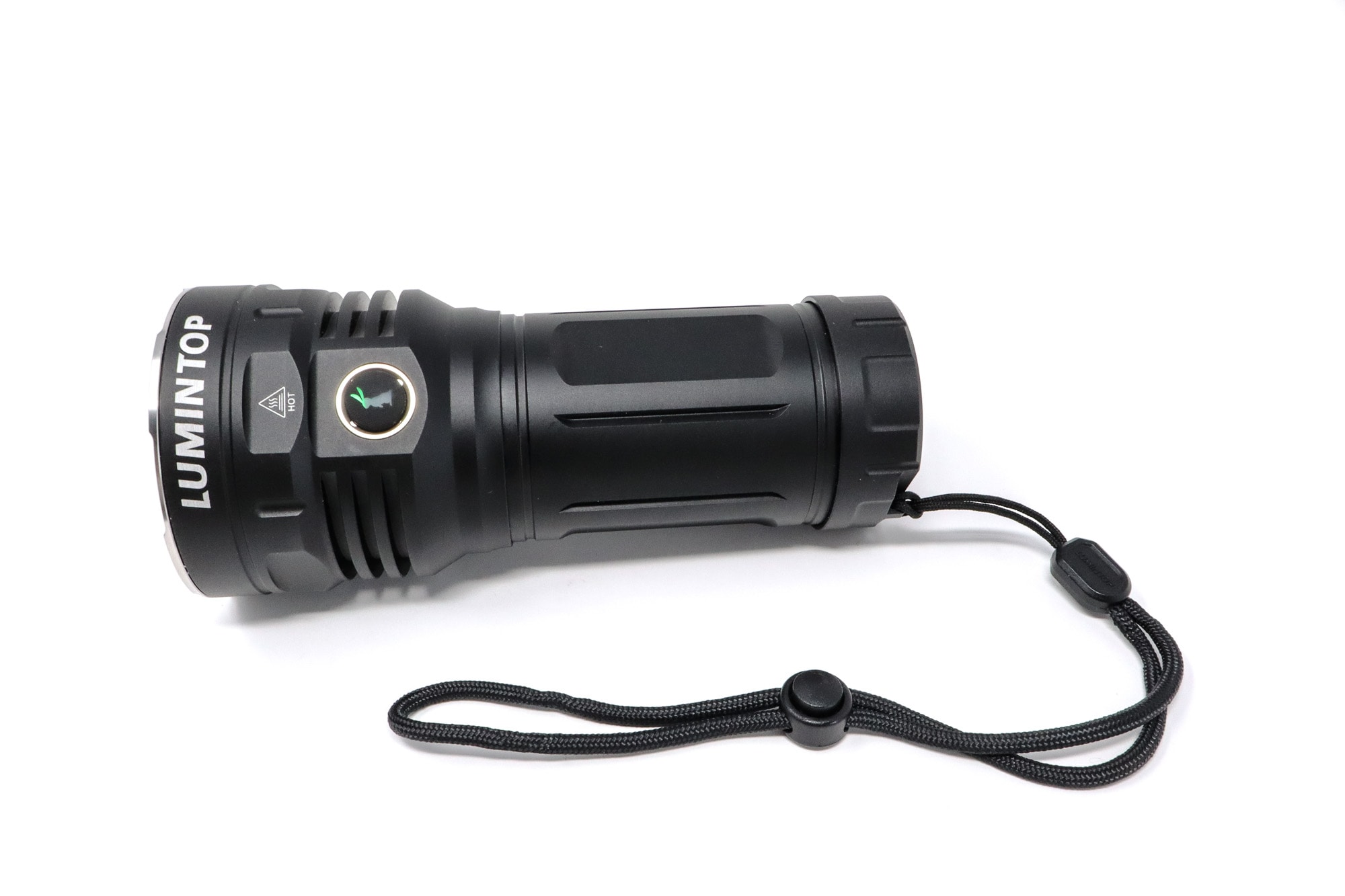
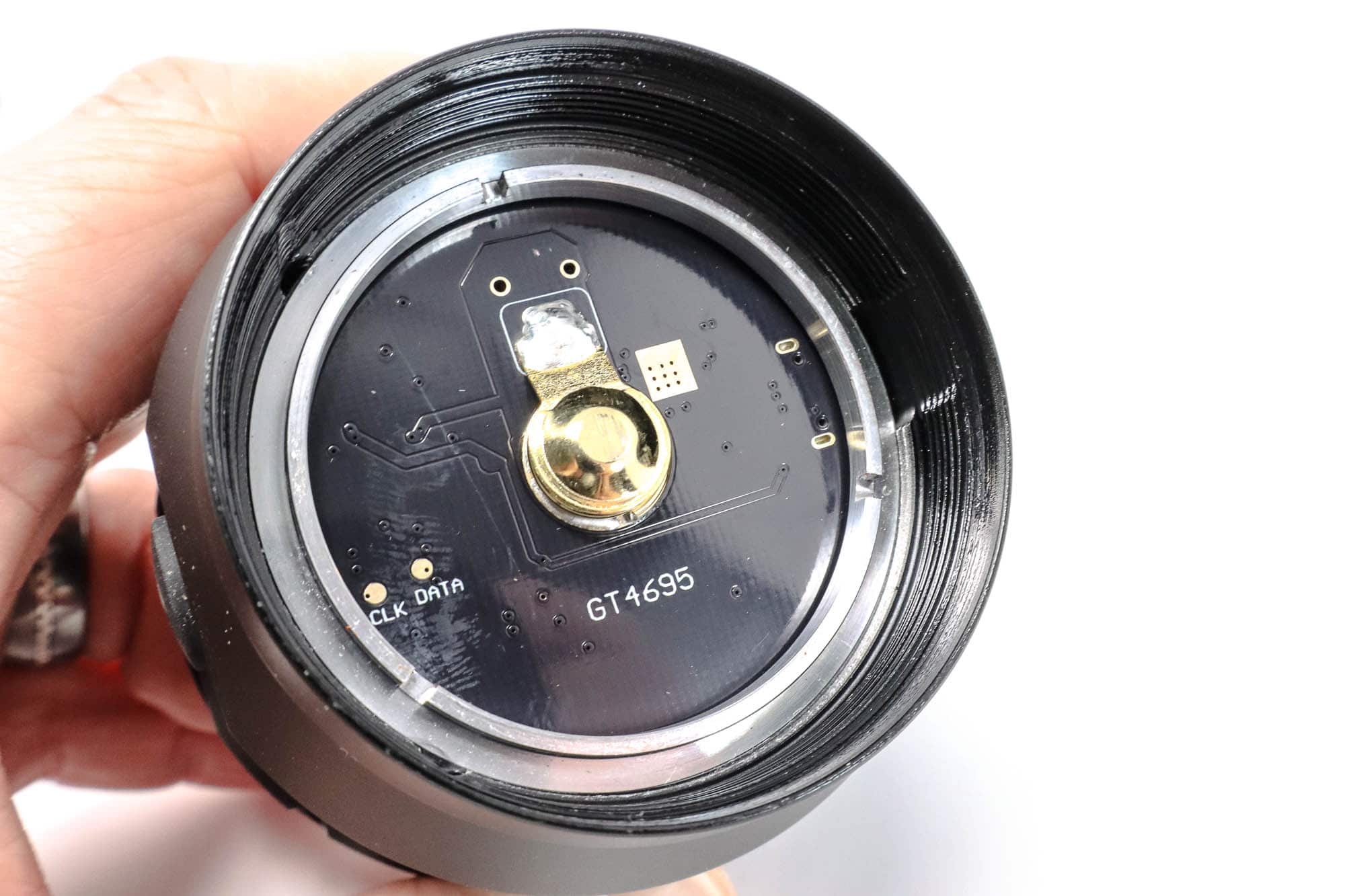
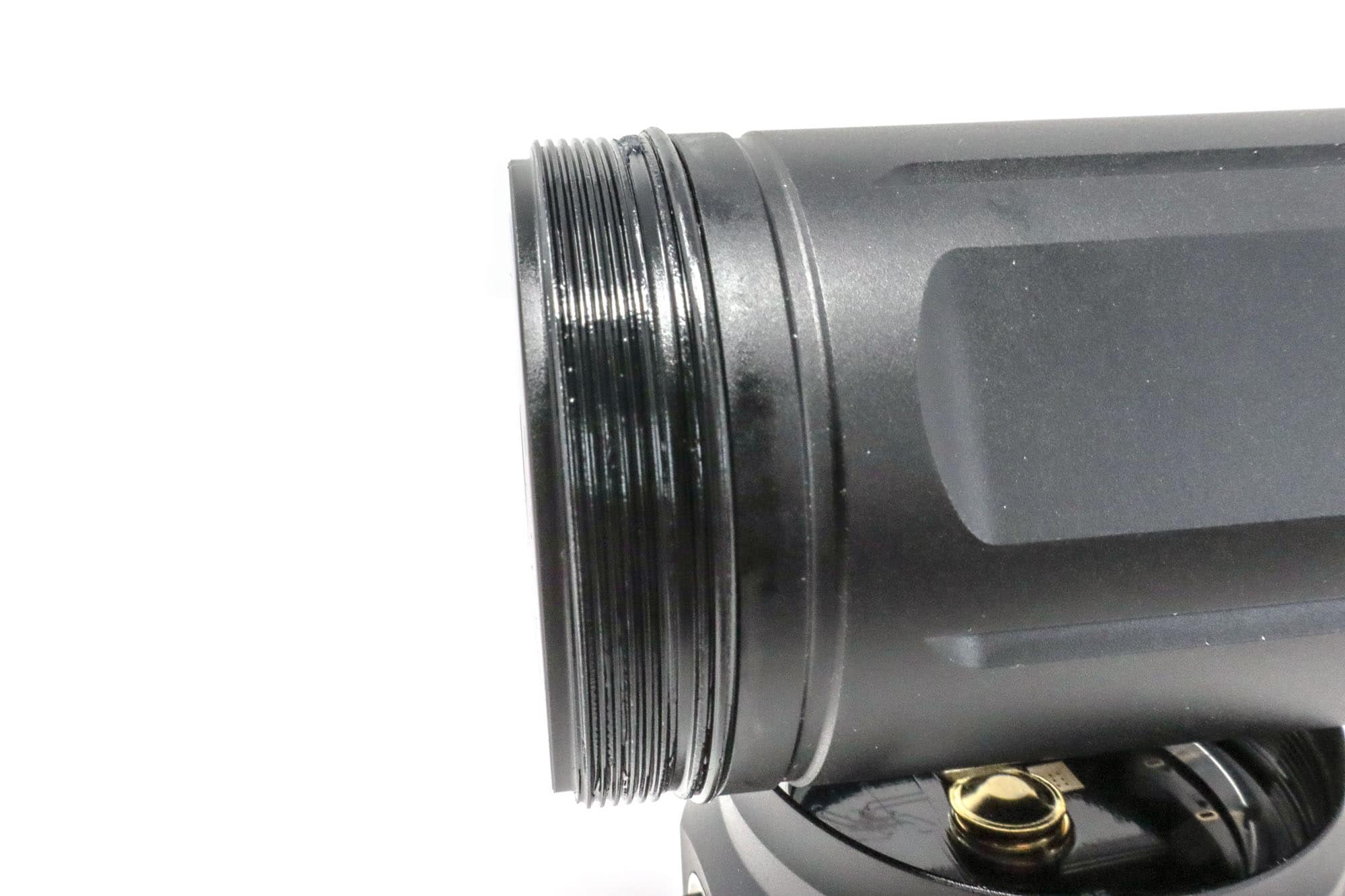
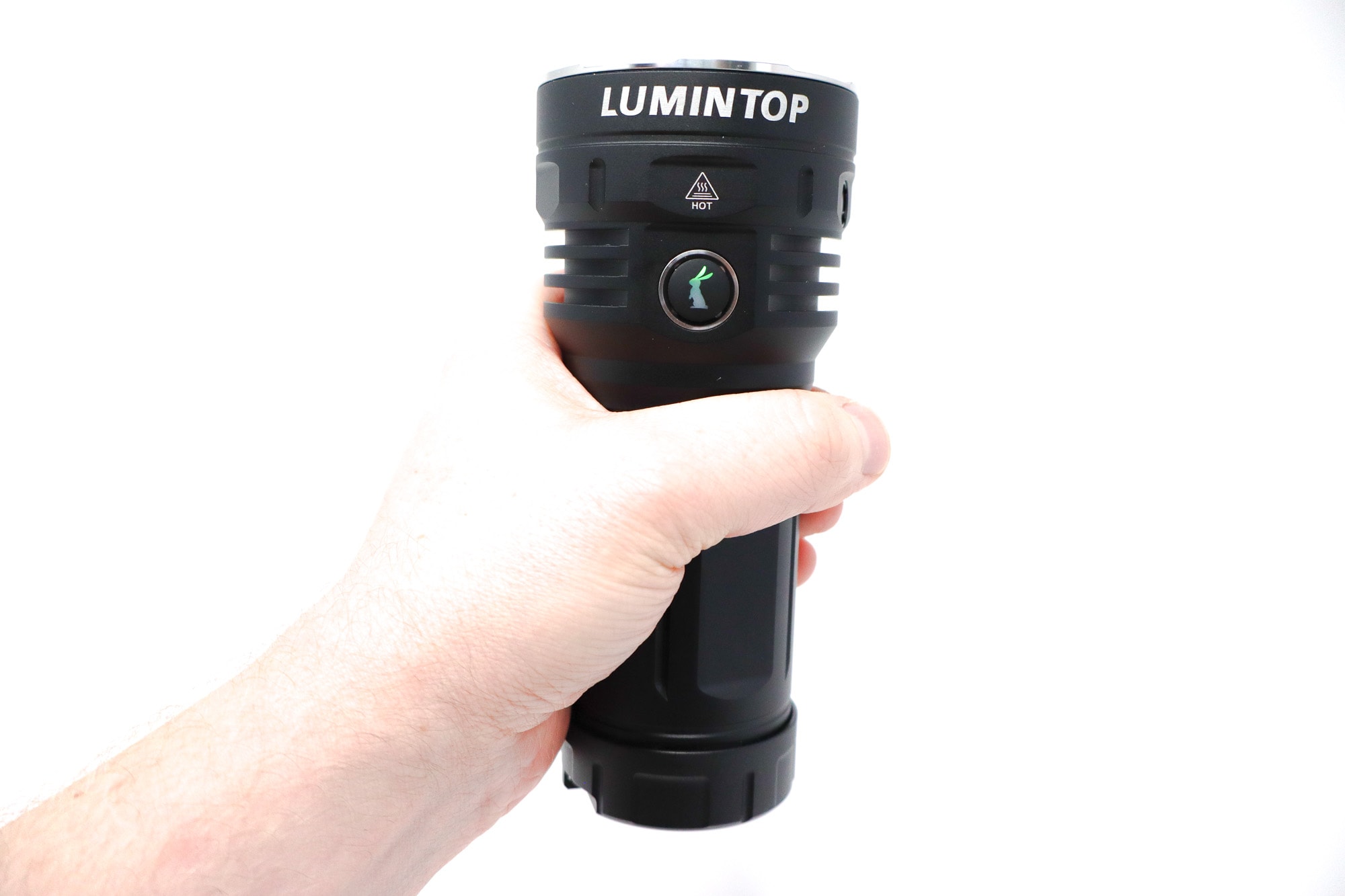
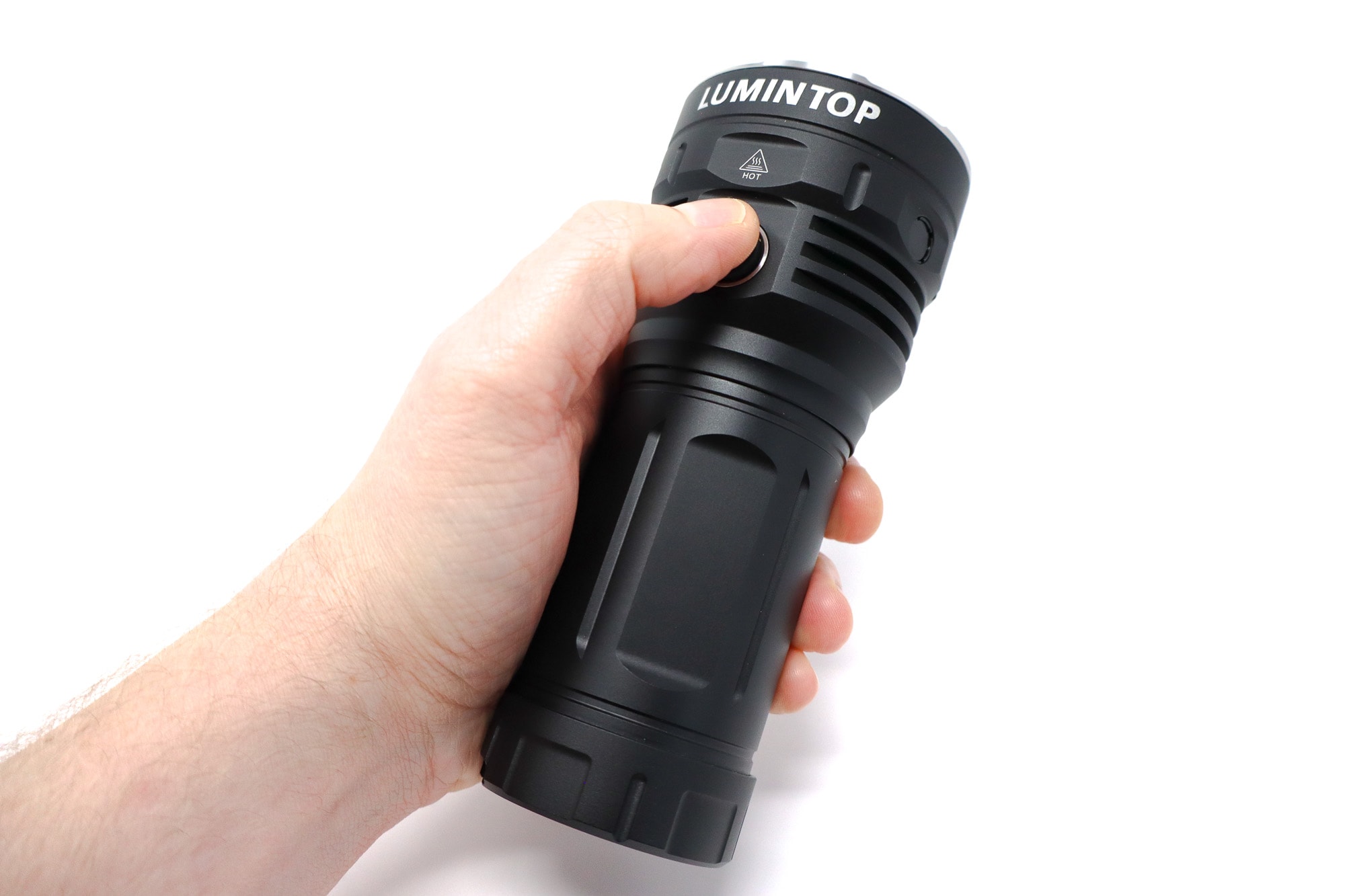
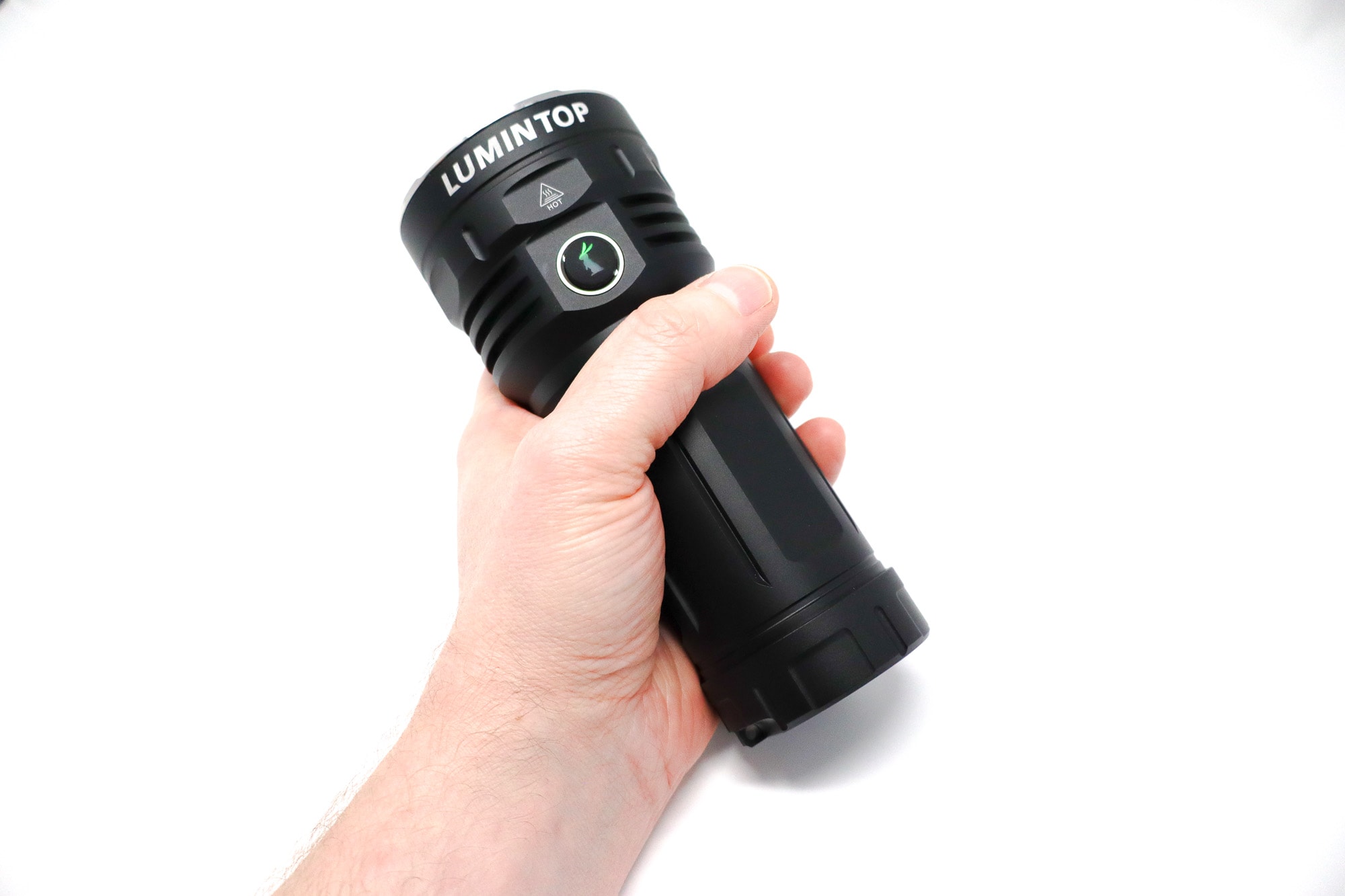
LED, Lens, Bezel, Beam, and Reflector
The LED has been transplanted from the Rattlesnake. It’s the SFP55, a huge 11 mm x 11 mm non homogenous high output emitter. It’s a platform shared by the SFP55.2L found in the Nightwatch NI03S Super Valkyrie. This is likely a product of San’an Optoelectronics, a huge LED manufacturer who also owns Luminus. Like a COB emitter, the LES is made up of 25 individual light emitting dies arranged as a 5×5 grid in parallel for 3 volt operation.
The bond wires are under the substrate, so this is a pretty robust LED, and the low vF means this thing gobbles electrons and poos out cool white photons like crazy. I tested the SFP55.2L in the Super Valkyrie and it easily pulled over 50 amps from the ultra spicy mystery 21700 and produced 13,000+ Lumens. Lumintop says the GT4695 is good for 160 watts of output, so this might usurp the NI03S as the brightest single cell, single LED flashlight. We’ll see. The reflector is a somewhat shallow LOP unit topped with a dual AR coated mineral glass lens. The bezel is stainless steel and finely finished. It has shallow crenulations, and should offer good protection to the lens. The beam has a lot of bright spill with a very huge, bright hotspot. There’s moderate tint shift, but the beam is tidy overall. There’s a lot of beam distance available here and illuminating objects 300 meters distant is very easy.
Spectral measurements:
I used the Opple Lightmaster Pro to measure the flashlight at 2 meters from the sensor.
| Mode: | CCT: | CRI Ra: | duv |
|---|---|---|---|
| Turbo | 6133K | 67 | 0.0045 |
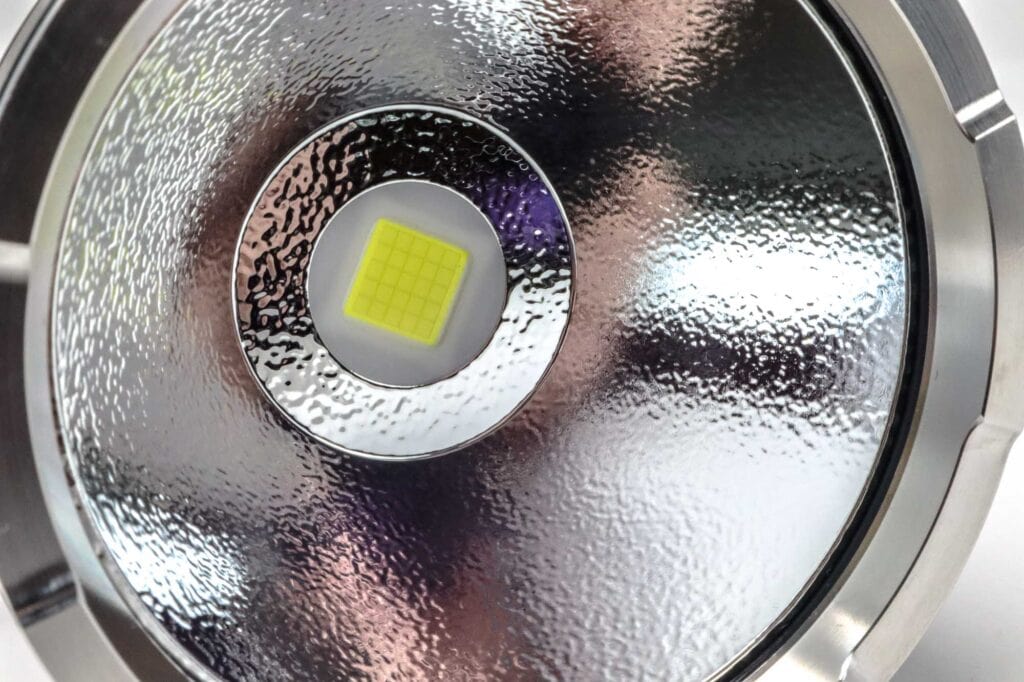
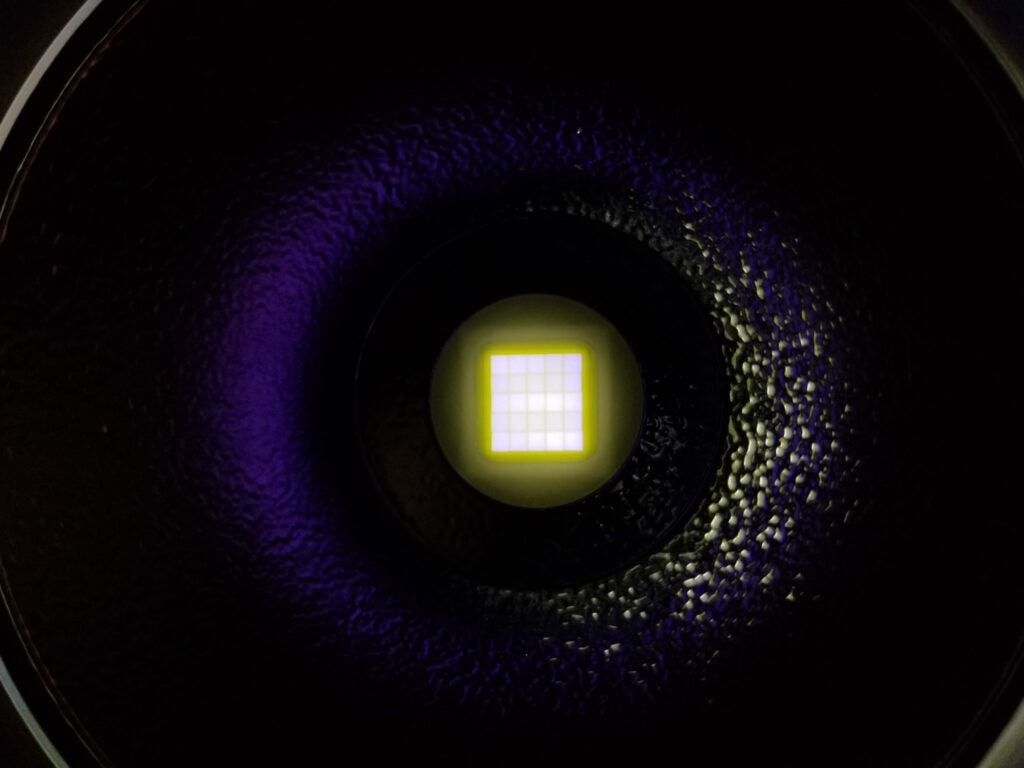
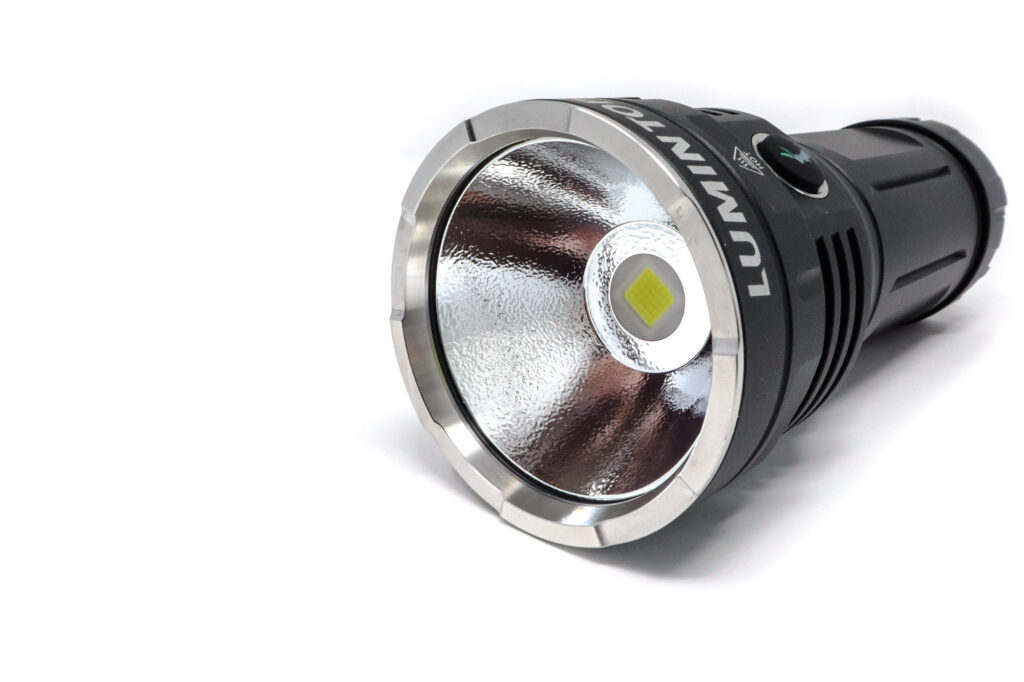
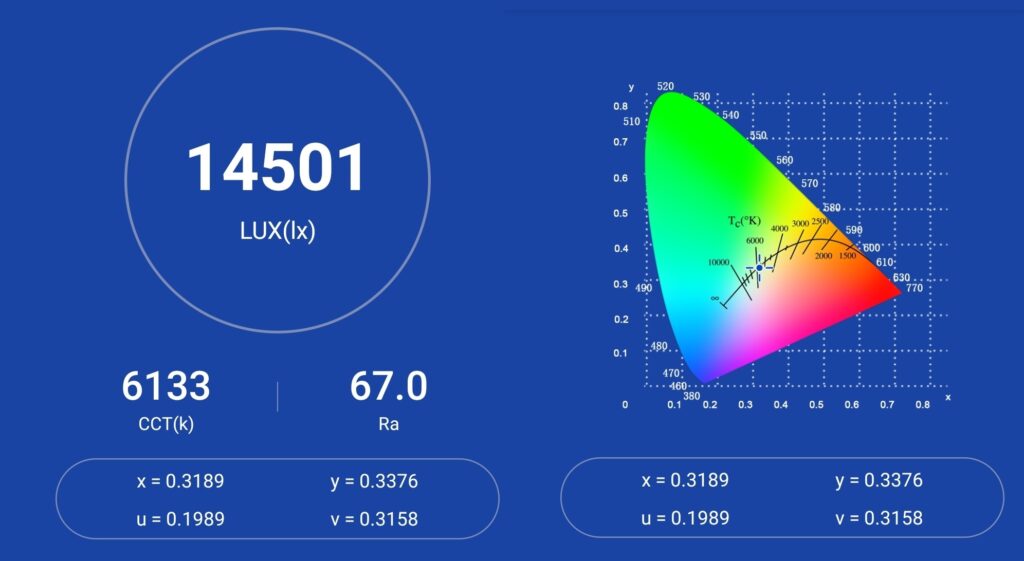
Dimensions and its competition
Dimensions:
| Lumintop GT4695 | Millimeters | Inches |
|---|---|---|
| Length | 159 mm | 6.2 in |
| Head diameter | 70 mm | 2.8 in |
| Body diameter | 52 mm | 2 in |
Dimensions are rounded to the nearest millimeter and the nearest tenth of an Inch.
Weight:
| Lumintop GT4695 | Weight in grams | Weight in oz |
|---|---|---|
| Without battery or handle: | 392 g | 14 oz |
| With battery and handle | 863 g | 30 oz |
Weight is rounded to the nearest gram and tenth of an Oz.
Flashlight size comparison with its competition:
Group 1 left to right: Lumintop Mach V1, Lumintop Mach 4695 V2, Lumintop Thanos 23, Lumintop GT4695
Group 2 left to right: Amutorch XT60 NB90.16, Lumintop GT4695, Nightwatch NI03S Super Valkyrie
Group 3 reflectors left to right: Amutorch XT60 NB90.16 (SFH55 LED), Lumintop GT4695 (SFP55), Nightwatch NI03S Super Valkyrie (SFP55.2L)
Group 4 left to right: Fenix LR60R, Lumintop GT4695, Ripsshine HF1, Acebeam E75
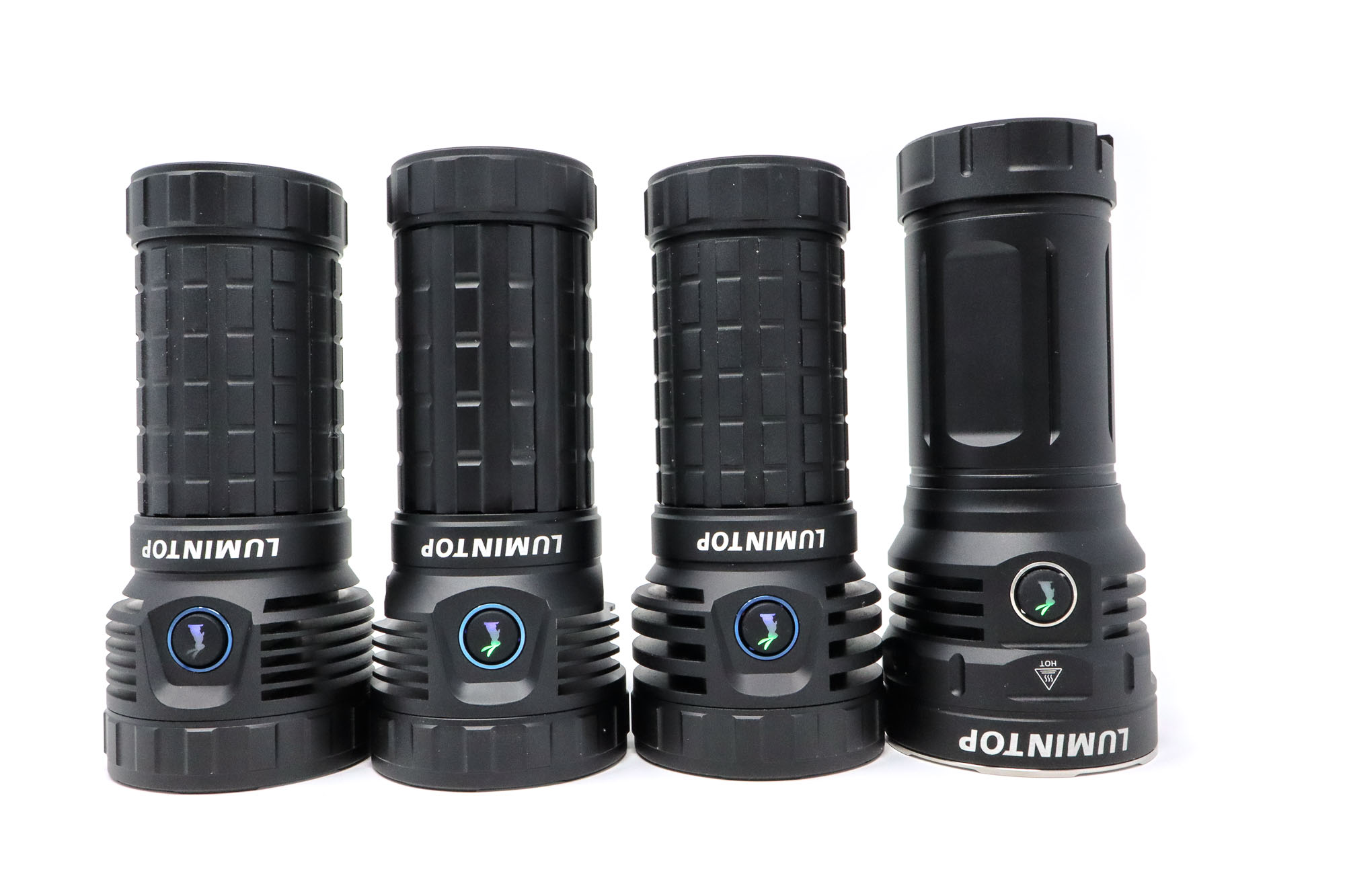
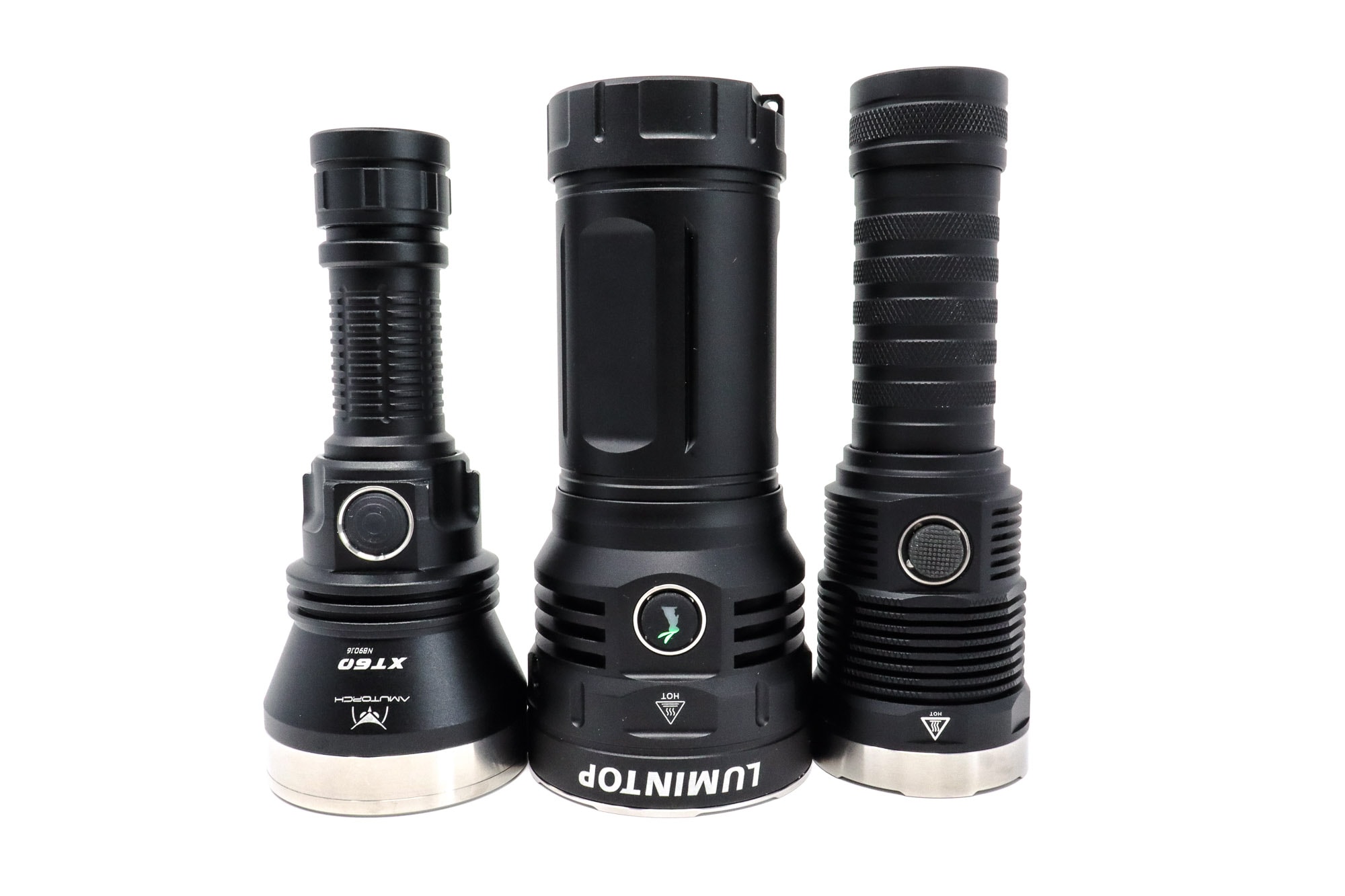
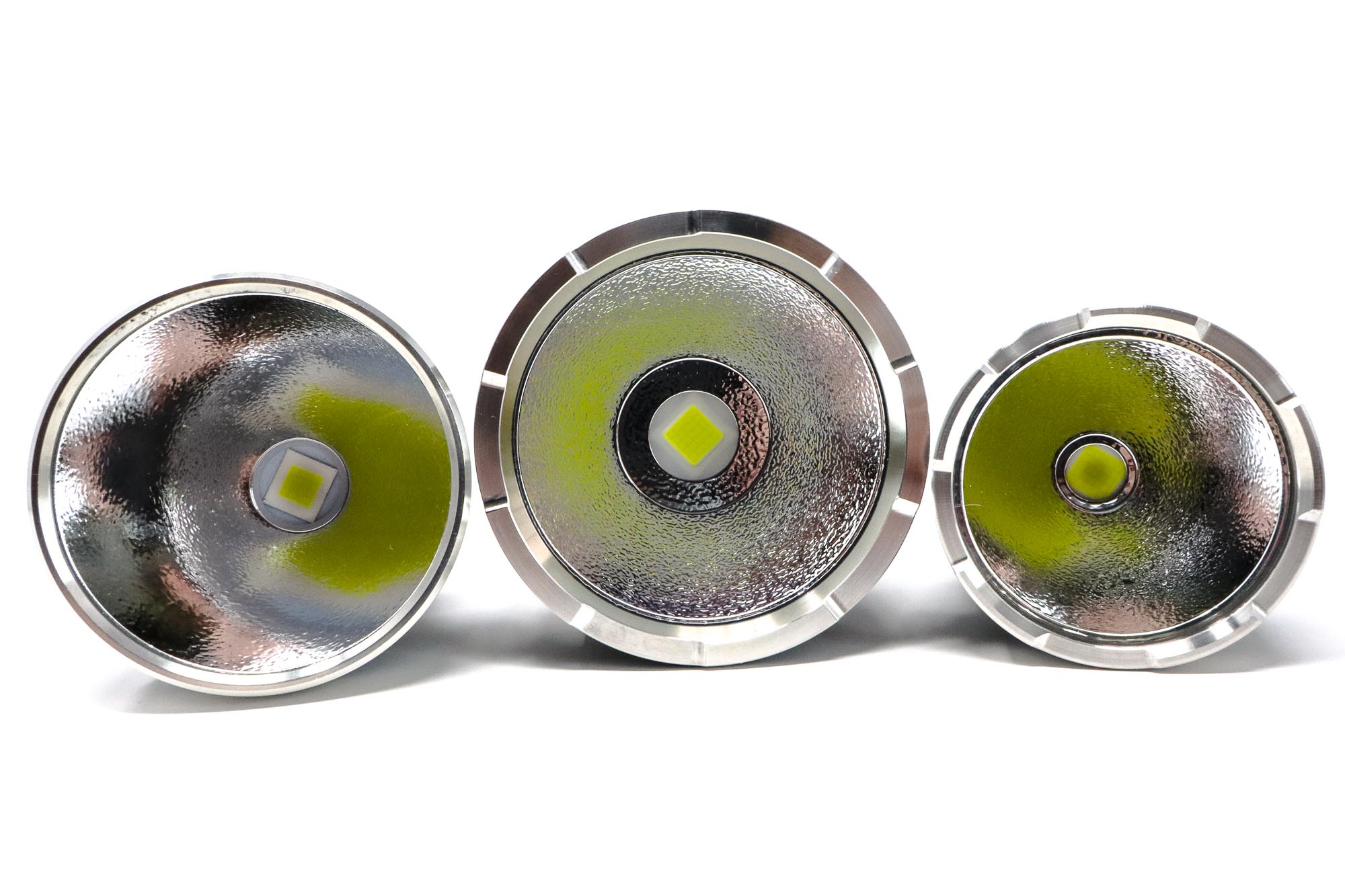
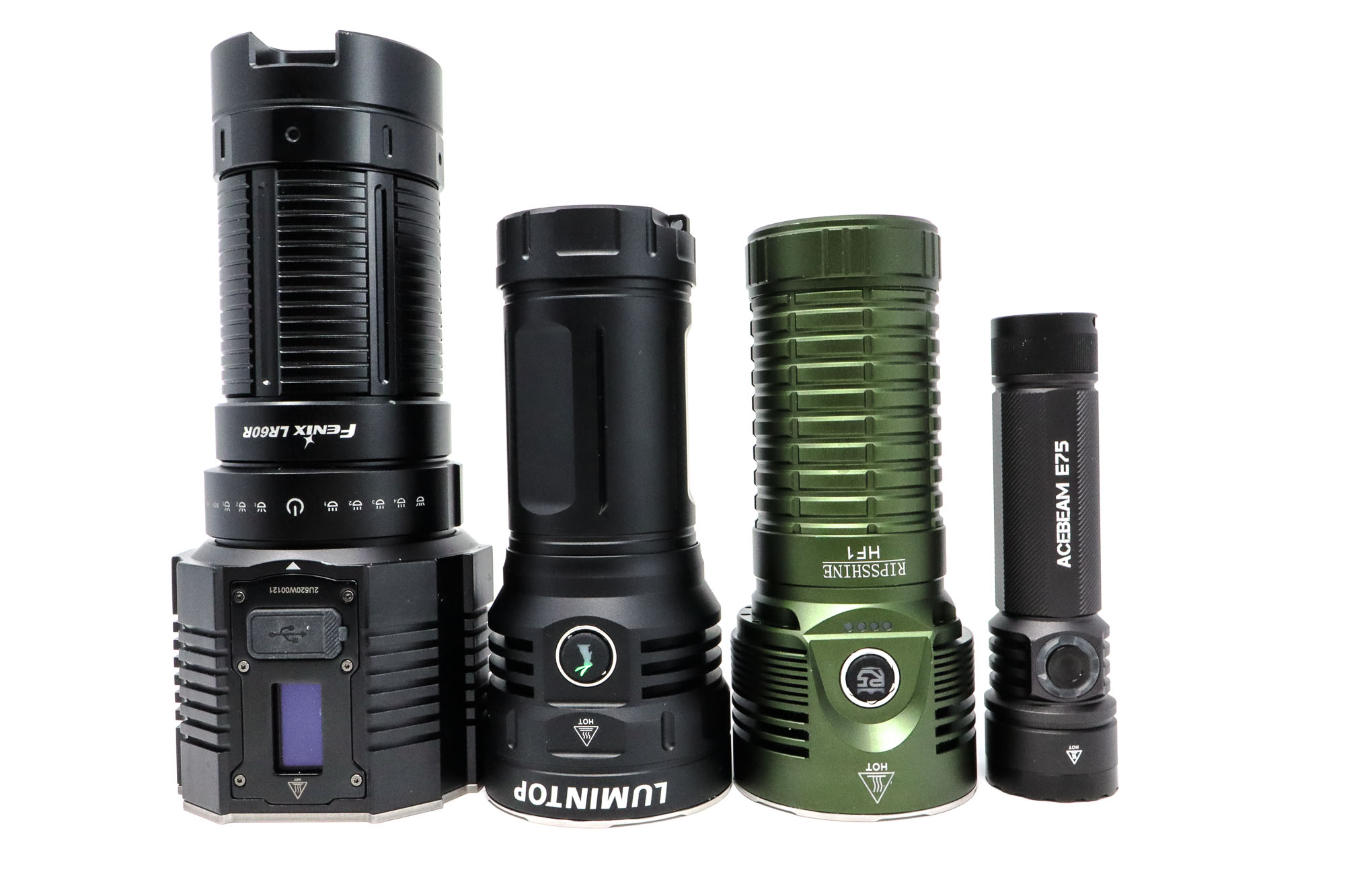
Lumintop GT4695 UI: User Interface and Driver
The GT4695 driver is unknown here, but it’s probably a linear FET driver with an AMC7135 regulator for lower modes and direct drive MOSFETS for Turbo.
The UI is carried over from the Mach 4695 with a couple revisions, so sorry if our readers were expecting Anduril. Again, I’m not splitting hairs over that since I liked the UI on the Mach(s), and it’s good here (albeit with a caveat). It’s a ramping UI with 4 modes, Moon, plus blinkies, and adds niceties like batt check, electronic lockout, and switch LED control.
Available modes:
- Smooth ramping with Moonlight, High 1 (top of ramp), High 2, Turbo
Available blinky modes:
- Strobe, SOS, Beacon Flasher
From OFF:
- Press and hold: Moonlight (double click in Moonlight for Strobe)
- Single click: Turns on in last memorized brightness level (only levels up to High 1 are memorized)
- Double click: Turbo. To activate High 2, double click while in Turbo.
- 3 fast clicks: Battery check. Like with Anduril, the light blinks out the battery voltage, e.g. four blinks, a pause, and a single blink is 4.1 volts, three blinks, a pause, and eight blinks is 3.8 volts.
- 4 fast clicks: Electronic lockout
- 7 clicks: Turns on/off switch LED
From ON:
- Press and hold: Ramps brightness up
- 1 click: Turns off
- Double click: Turbo
- To activate High 2, double click in Turbo
Mode memory:
- Remembers last brightness level up to High 1 (top of the ramp). Moon, High 2, Turbo and blinkies are not memorized
Shortcuts:
- To Moon: From off, long press switch for 1 second
- To Turbo: 2 clicks from on or off
- To Strobe: In Moonlight, double click to activate Strobe. To cycle through SOS and Beacon, double click again for each mode
Low voltage warning/protection:
- The light will drop to a very low level when the batteries reach a certain low voltage (not specified in the manual)
Strobe/blinkies
- Strobe, SOS, Beacon Flasher
Lock-out mode:
- Electronic lockout. From off, click the switch 4 times to activate lockout. Momentary Moonlight mode will be available in lockout. To deactivate lockout, repeat the 4 clicks.
PWM
- Fast PWM not visible to the naked eye
Additional/summary info on the UI:
- Well, it looks like Lumintop did a switcheroo on this one. Aside from the flip-flopped Turbo/High 2 switching, this is a pretty good UI. Again, I don’t like the backwards way to get to High 2, and I don’t know why it’s that way, but it is, so here we are.
- There’s obligatory intelligent temperature control and LVP present as well. The ramping isn’t super-smooth either and kind of jittery when ramping up and down. Again, a nice effort, but no Anduril!
Lumintop GT4695 Charging and batteries
If you haven’t guessed where the ‘4695’ in the naming convention comes from yet, it comes from the 46950 li-ion. The GT4695 is sporting one of the largest consumer li-ion batteries right now. The included cell seems built into the light and not (supposedly) removable. It’s a ‘customized’ (aka proprietary) cell with the anode and cathodes on the top. This is a monolithic cylindrical 4.2 volt lithium ion cell originally designed for electric cars. It’s 46 mm wide, 95 mm long and typically has around 32,000 mAh or up to 118 Wh.
The other specs? How about total discharge power approaching 900 watts? For charging, it uses a USB type C for the input/output (power bank) at QC2.0/3.0 speeds with PD up to 12v 1.5 amps on the charging and 9 v 2 amps on the output (18W). The instructions say up to 4 amps on the charging, but I guess it’s part of the Huawei FCP 20W and you need a FCP charger for that. On my Hidance USB C tester, I saw about 18 watts max for charging on a 45W wall wart, and 18W for the power bank. It’s not slow, but I think it should be higher and yes, same gripe as the Mach 4695, so I’ll say it again:
Lumintop, can we get 45W PD charging for this? Strangely, the GT4695 charged the battery faster than the Mach 4695. It took about 8 hours to recharge the cell after a runtime, and the termination voltage was 4.18 volts. The Mach took around 10 hours.
| Charge type | Fits | No fit | Charge time |
|---|---|---|---|
| Flashlight with onboard USB-C | 46950 only (battery is integrated) | Everything else | About 8 hours |
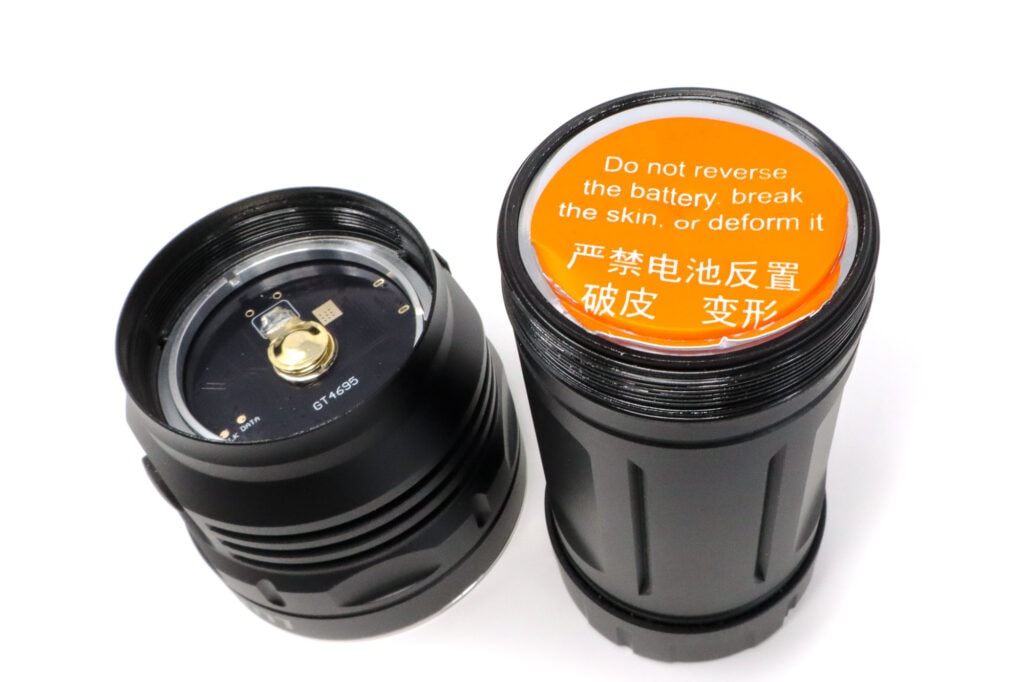

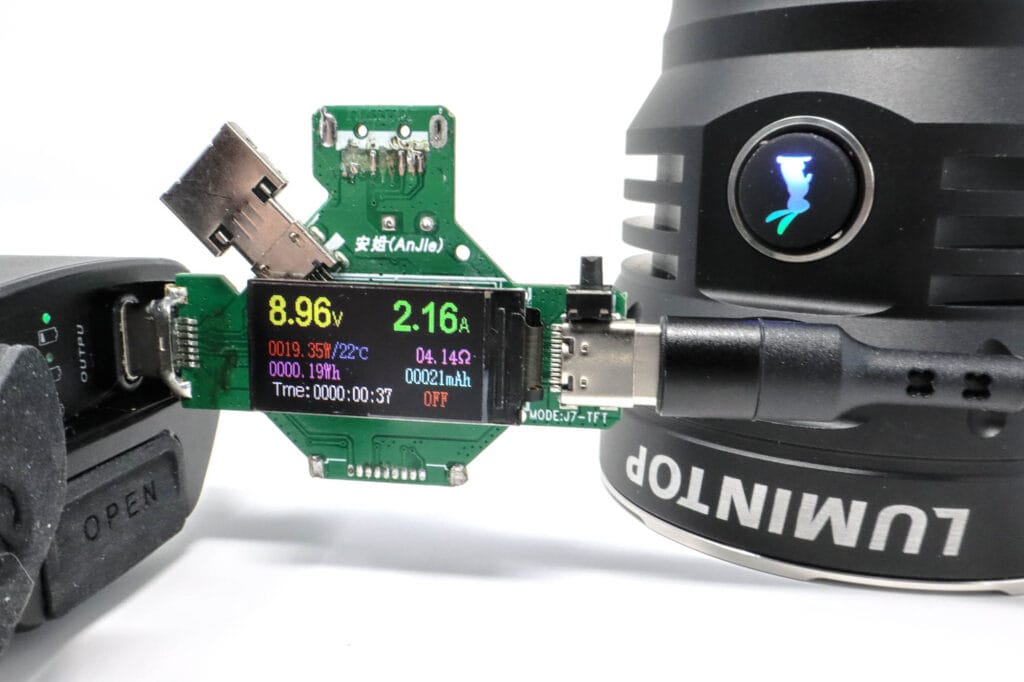
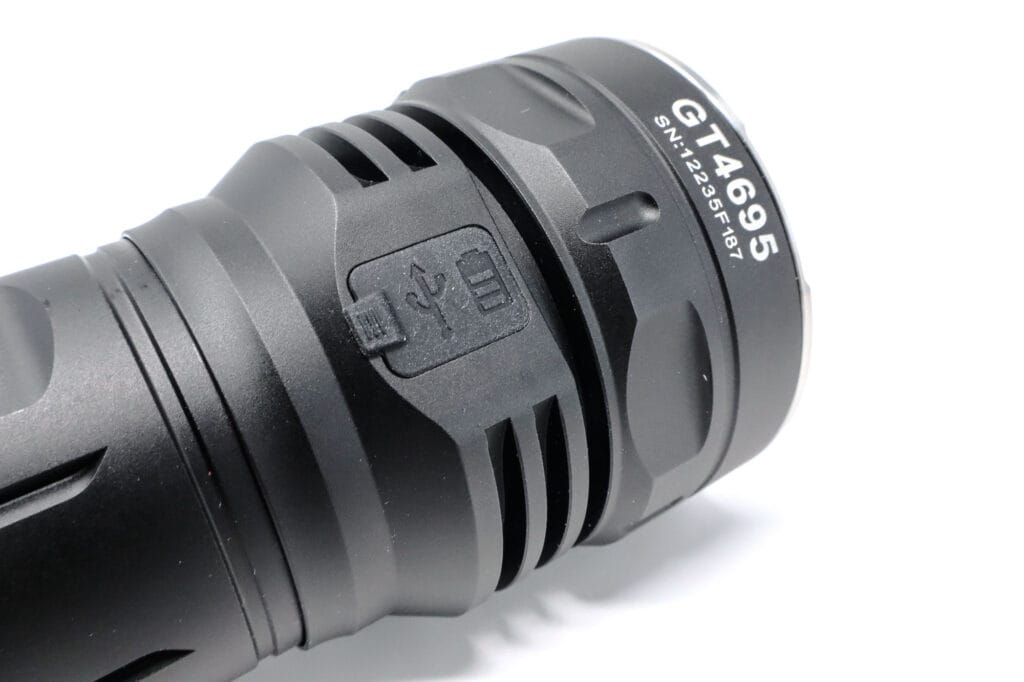
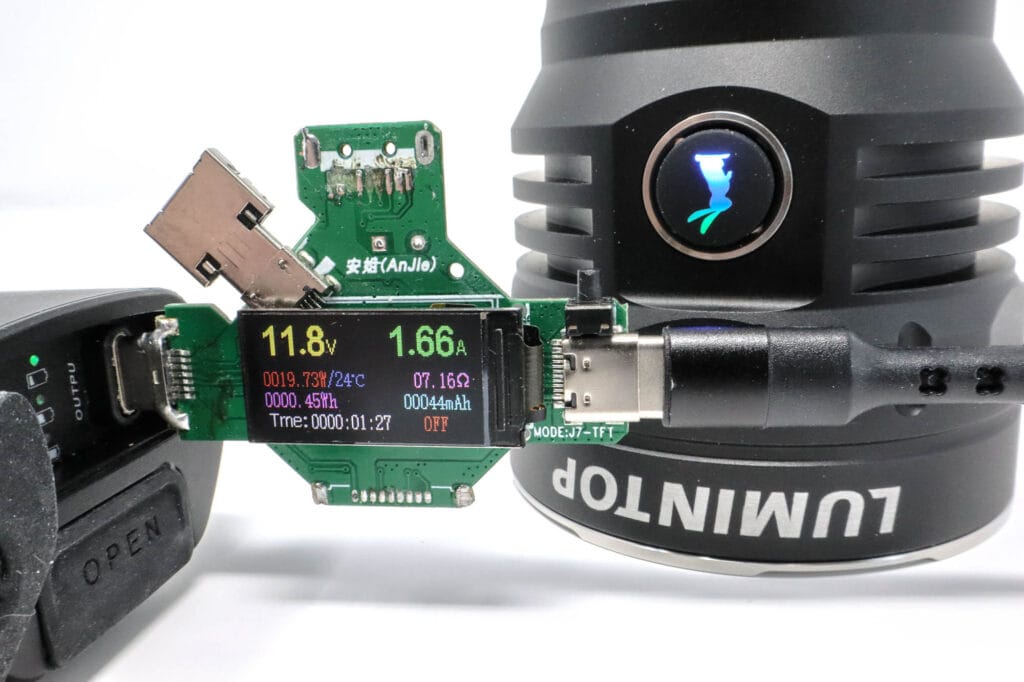
Performance test
Lumen measurements
How Lumens are Measured: Understanding ANSI FL1 Standards How Lumens are Measured: Understanding ANSI FL1 Standards: The ANSI FL1 standards specify that output in lumens should be measured 30 seconds after turning on, as this is the standardized time for measuring brightness according to the industry standard. This is why we focus on this part in our measurements. The ANSI FL1 standards require an ambient temperature of 22 ± 3°C. We record the ambient the ambient temperature to identify potential reasons for any observed discrepancies.Lumens are measured in my 50 cm integrating sphere with a Digi-Sense 20250-00 data logging luxmeter. The sphere has been calibrated with a Convoy S2+ measured to 260 Lumens and the figures are within 10% of actual. No current measurements this time due to the (mostly) inaccessible current path. I usually don’t test current on soda can lights due to the risk of shorting something and releasing the magic smoke.
| Mode | Specified | Turn on | 30 sec. | 10 min. |
|---|---|---|---|---|
| Moon | 1 | 1.2 lm | 1.2 lm | – |
| High 1 | 2000 | 1845 lm | 1845 lm | 1722 lm |
| High 2 | 6000 | 5904 lm | 5658 lm | 1722 lm |
| Turbo | 15,000 lm | 12,177 lm | 3444 lm | 1722 lm |
Ambient temperature during testing:
- 19.5°C
Parasitic drain:
- N/A µA/mA
The outputs are again, optimistic on the specs versus my results, but not bad for a single LED. At 10 minutes after all the step downs, the outputs are identical for all modes.
Lumintop GT4695 Battery Life: Runtime graphs
How Runtimes are Measured: Understanding ANSI FL1 Standards About ANSI FL1 runtime standards: The runtime is measured until the light drops to 10% of its initial output (30 seconds after turning on). This does not mean that the flashlight is not usable anymore. The last column shows how long the light actually works till it shuts off. If there is a + symbol, it means that the test was stopped at that particular point, but the light was actually still running. This happens on certain occasions, with certain drivers, firmware, or batteries.Lumens are measured in my 50 cm integrating sphere with a Digi-Sense 20250-00 data logging luxmeter. The sphere has been calibrated with a Convoy S2+ measured to 260 Lumens and the figures are within 10% of actual. I use a Digi-Sense 20250-92 data logging thermocouple for the temperature measurements. The probe is affixed to the head using kapton tape and uses the same 5 second sampling rate for logging.
I measured High 1, High 2 and Turbo. The battery was allowed to fully charge before each test.
| Mode | Specified | Runtime (ANSI FL1) | Time till shut off |
|---|---|---|---|
| High 1 | 9h | 8h 14min | *8h 14min |
| High 2 | 50s+8h 50min | 7h 25min | *8h 9min |
| Turbo | 30s+8h 50min | 4h 31min | *8h 12min |
*The light was still running at a very low level when the test was terminated.
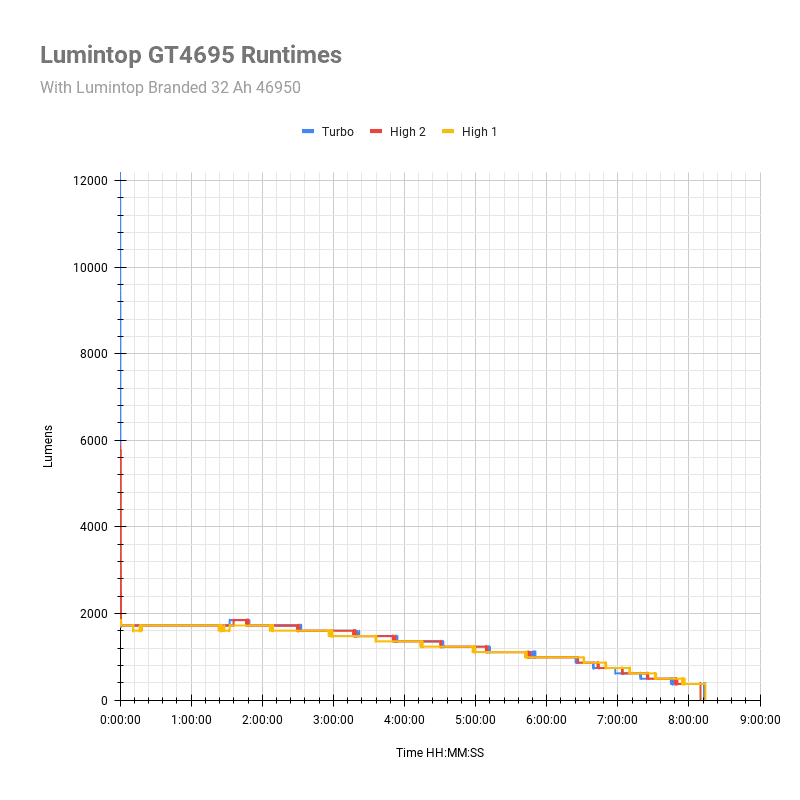
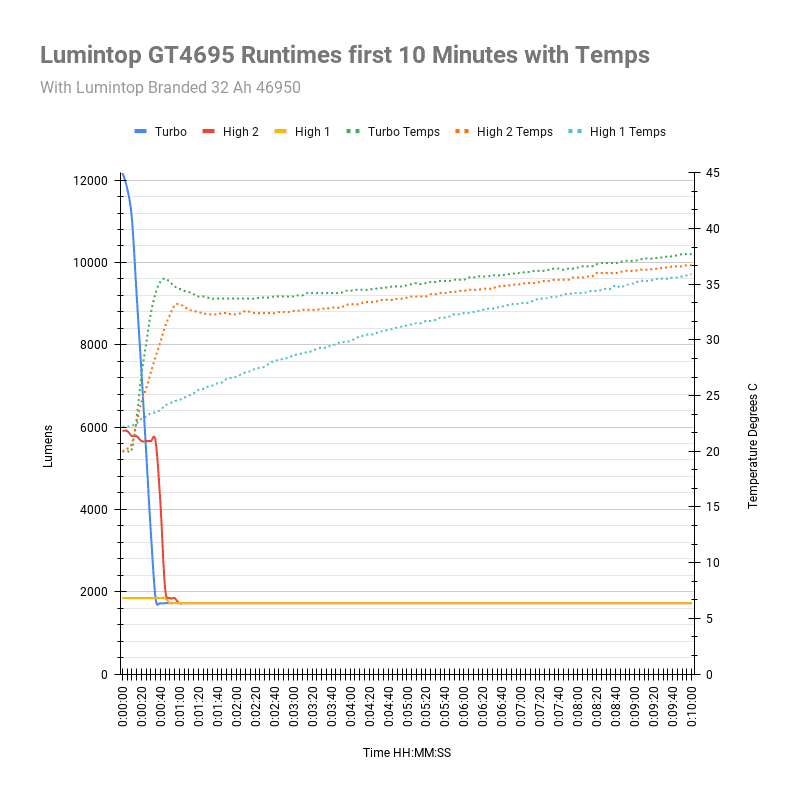
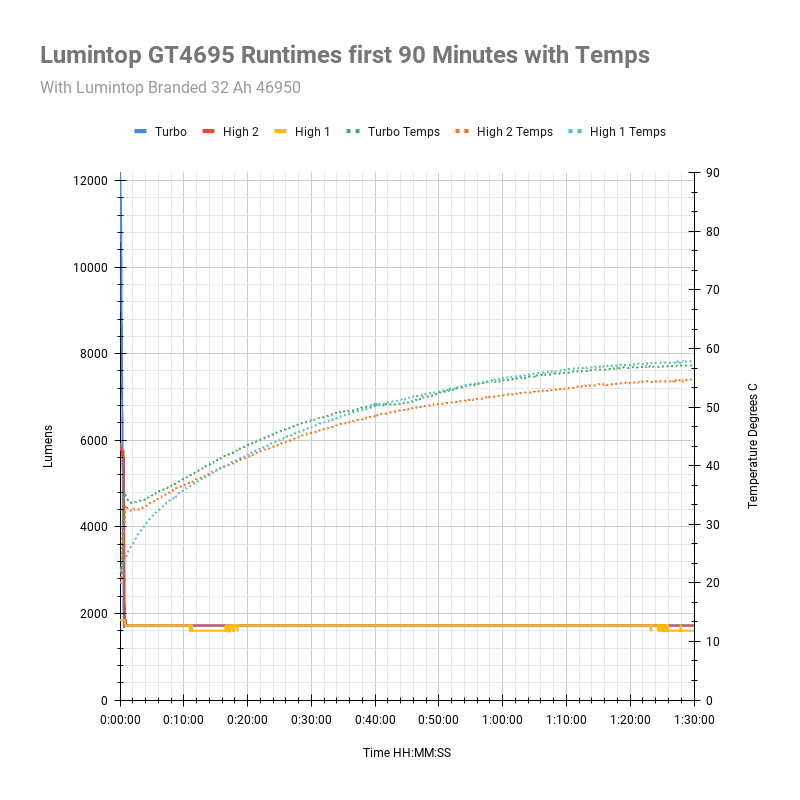
For the runtimes, as expected there’s a brisk, deep step down from Turbo and High 2 from turn-on around 30 seconds and 50 seconds (respectively). After that, the output decreases in steps as the battery drains, so no, this isn’t a regulated driver. It’s not terrible though with the nonsensical, ridiculous step downs to under 200 Lumens like I see on some Anduril hotrods.
Thanks to that huge battery, there’s a very gradual decrease in output until each mode drops to a very low level and off the luxmeter around 8 hours in. The light was still running at a low level (about 45 Lumens) when I ended the testing, so you still get usable amounts of brightness even after LVP. Higher brightness can be called up, but it steps down almost immediately back to the low level.
The output is thermally regulated to around 55 C, and the highest temps I saw during my testing never went over 60 C. My thermocouple stopped logging around 2 hours in, so I only got reliable data for all modes for 1 hr. 30 minutes. It’s hand-friendly for about 15 minutes, but after that the tube gets up to 52 C. Okay for gloves, not bare hands and I think this is where a handle would be helpful. The battery was consistently discharged to between 2.9 and 3.1 volts after the tests.
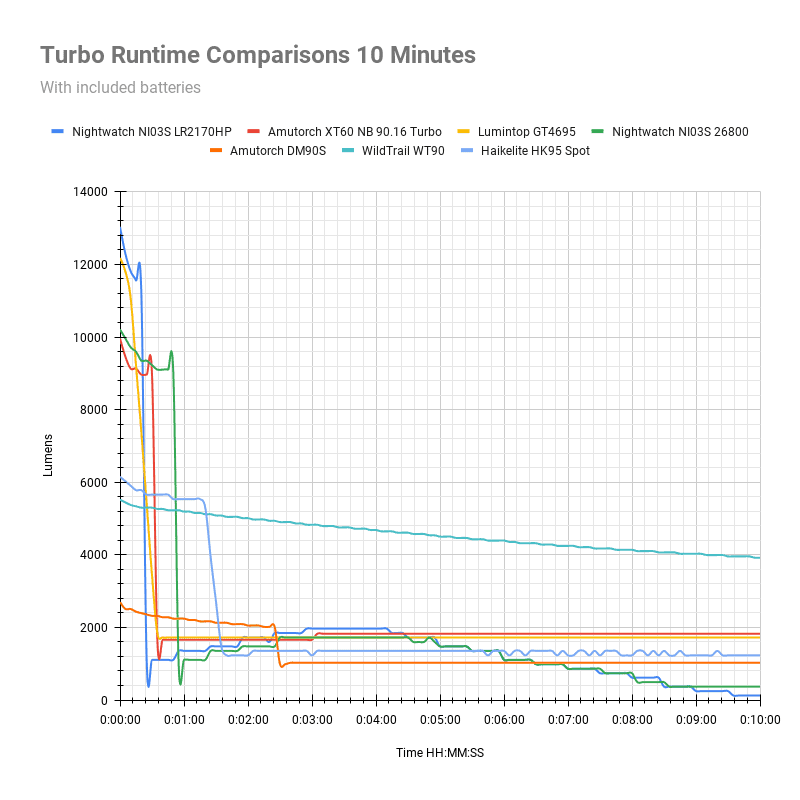
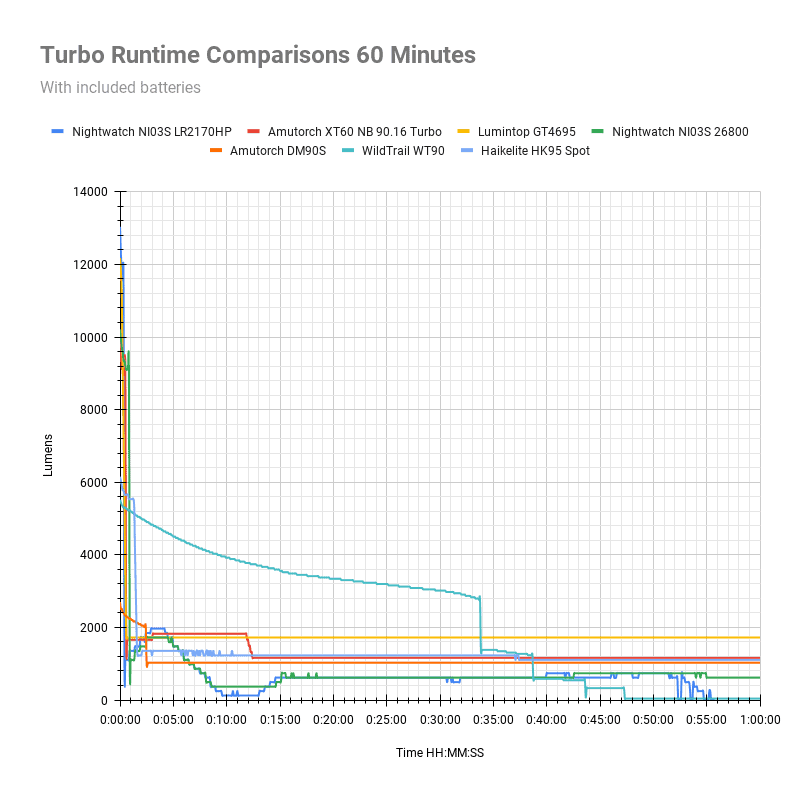
I compared the GT4695 to the other contender for single-cell, single-LED brightest flashlight on earth, the Nightwatch NI03S Super Valkyrie, which has the SFP55.2L LED. Sadly, the GT4695 couldn’t dethrone it with the NI03S getting up to a bit over 13,000 Lumens, but that’s with one of the highest-performing 21700s you can get. (NI03S) With its default 26800 cell, the Lumintop GT4695 is brighter.
The Amutorch XT60 NB90.15 with the SFH55 LED, hits almost 10,000 Lumens, while the Haikelite HK95 with the same LED only manages about 6000. The other brightest single LED lights I have are the SFN55.2 equipped NI03 (non-super) Valkyrie, and some SBT90.2s, with 50% less output. The huge WT90 is the sustained output winner for the first 35 minutes before petering out.
Peak beam intensity and beam distance measurements
About Peak beam intensity: Understanding ANSI FL1 Standards About peak beam intensity The calculated value of distance in meters at which the flashlight produces a light intensity of 0.25 lux. (0.25 lux is about the brightness of a full moon shining on an object). This means that the intensity has decreased so much, it becomes difficult to see darker objects, or objects that don’t reflect light. The columns ‘Meters’ and ‘Yards’ use rounded numbers.Beam distances are measured using a Uni-T UT383S luxmeter measured indoors at 5 meters using the included fully charged 46950 battery. Measurements taken at 30 seconds. The light was recharged and allowed to cool between the High 2 and Turbo tests.
| Mode | Specified | Candela measured | Meters | Yards |
|---|---|---|---|---|
| Moon | ? | 75 cd | 17 | 19 |
| High 1 | ? | 22,000 cd | 297 | 325 |
| High 2 | ? | 69,050 cd | 525 | 574 |
| Turbo | 160,000 | 20,905 cd | 289 | 316 |
| Turbo at turn-on | ? | 142,225 cd | 754 | 825 |
Ambient temperature:
- 19 °C
Lumintop only lists a single candela spec for the beam distances. I assume it’s for Turbo. Turn-on comes close, but at 30 seconds, the output has really throttled back down about 60%.
Beamshots
Camera settings and distance: Photos taken with a Canon EOS R100 with Canon RF-S 18-45 mm STM lens. The camera is set to 0.3s, F5 ISO1600 and 5000K WB. The fence is 95 meters away.
Beamshots of the following flashlights compared:
- Lumintop GT4695
- Lumintop Mach 4695 V2
- Nightwatch NI03 Valkyrie
- Nightwatch NI03S Super Valkyrie
- Amutorch XT60 NB90.16
- Haikelite HK95 (spot mode)
Please note that the following beamshots are mainly intended to showcase the beam pattern and beam quality, rather than overall performance. These images are typically taken directly after activation, and in different seasons or weather conditions, and therefore do not fully represent its overall performance. For accurate performance metrics, such as output, beam distance, and runtimes, you need to look at the performance section of this review.

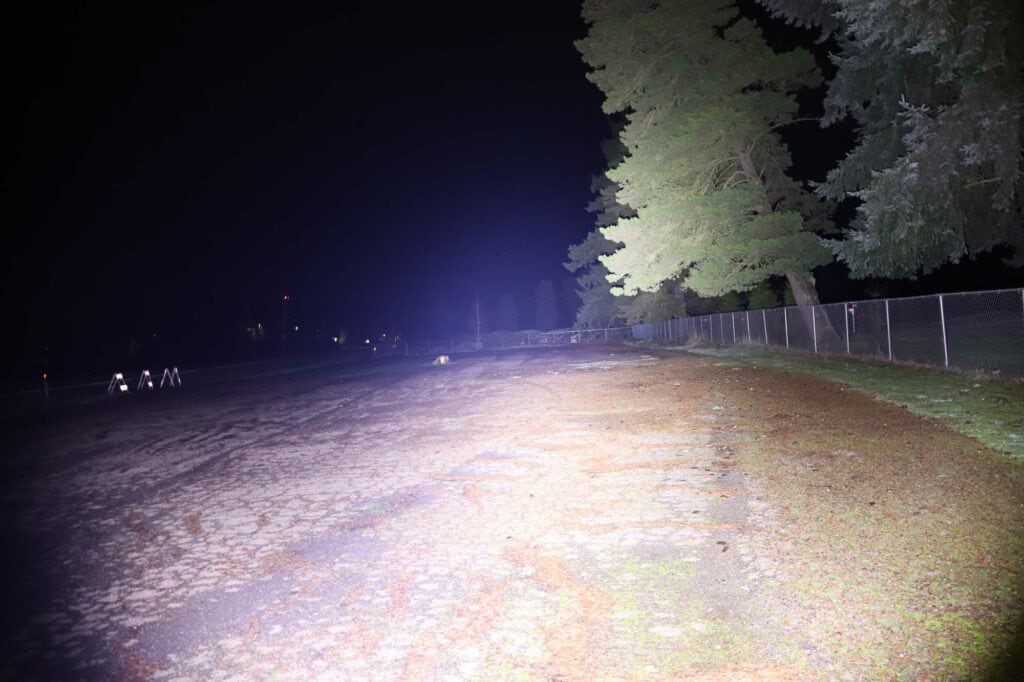

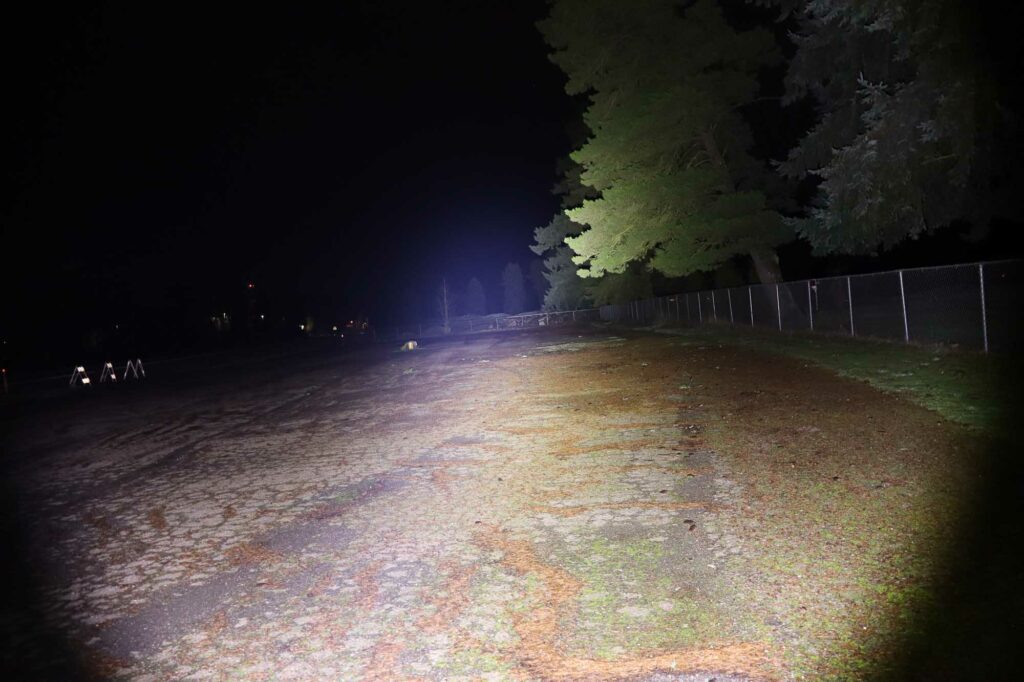
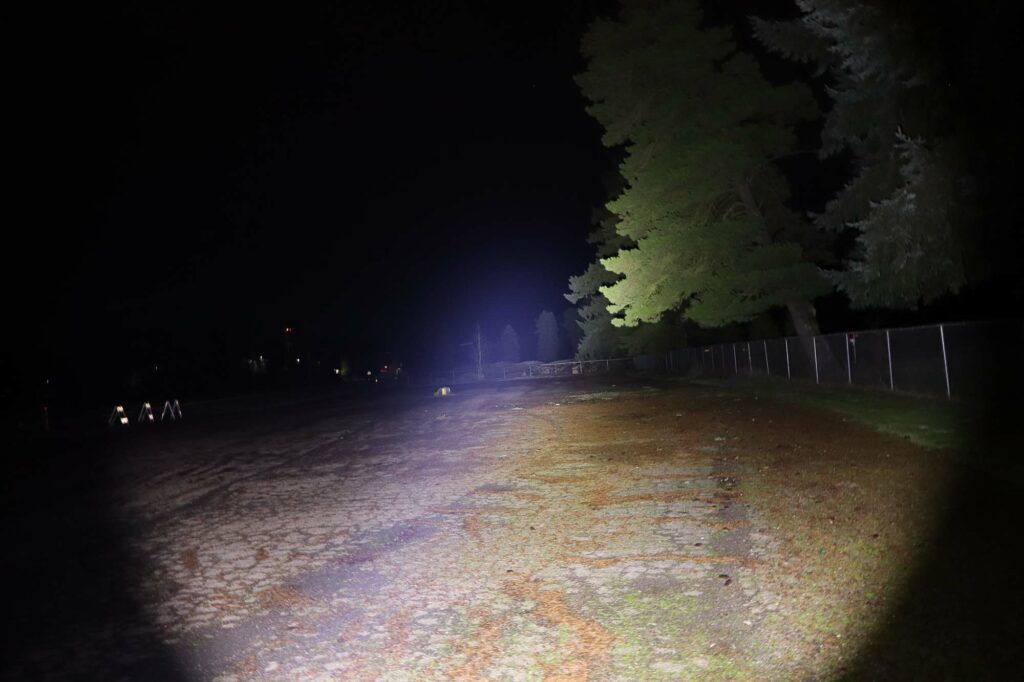

Disclaimer: This flashlight was sent to us for review at no cost by Banggood. We have not been paid to review, nor have we been holding back on problems or defects.
Final Verdict
Pros
- Decent sustained output
- Very long runtimes
- Onboard USB C charging
- SImple ramping UI
- Nice build quality
Cons
- Fast Turbo step downs
- Charging could be a bit faster
- Didn’t meet output specs
- 46950 battery is built-in
- No handle?
Explanation on star ratings:
1: Avoid: a match would be a better choice – 2: Poor: significant defect or issues; almost unusable – 3: Average: some defects or issues; but still usable 4: Good: recommended (minor issues) – 5: Great: highly recommended

4 stars: ★★★★
While our star rating provides a reliable indicator, we encourage you to read the full review to make an informed decision based on your own needs and preferences.
This is the third light featuring the 46950 battery, and I’m glad to see it being adopted for flashlights that can benefit from it most, e.g. soda can or soup can lights that originally would have been powered by multiple 21700 or 18650’s. These same lights can easily be adapted to be powered by a single 46950.
However, there’s lots of room for improvement, and the implementation still hasn’t matured due to limitations with available 1S drivers. The Ripsshine HF1 as the exception, most of these lights have FET drivers and these cells can really benefit from high power boost drivers running multiple LEDs in series/parallel. I think Lumintop did an okay job here. I’m not crazy about the built-in battery. It’s heavy and bulky, but not overly so, and this comes with the territory.
Also consistent with lights of this type is super quick down on the higher modes. However, you get decent output for the first few minutes, with acceptable output afterward and extremely long runtimes that no multiple 21700 light could touch. The thermal regulation is also decent and unintrusive, and as always, I appreciate Lumintop opting for a simple UI instead of Anduril.
While the charging was faster than the other 4695 lights I’ve tested, I find myself wanting faster charging. The big battery could certainly benefit from 45W charging, and this isn’t a very practical flashlight to begin with, made less so by the absence of a handle.
Overall, I think the GT4695 is a somewhat unique light and if you’re looking to get into the 46950 cell with the second brightest single cell (at turn on), single LED light in the world, this is currently the most affordable option. I believe there’s more potential for future improvements. Maybe on the V2? For now, 4 stars for the GT4695.
Buy your Lumintop GT4695 here
1lumen selects and reviews products personally. We may earn affiliate commissions through our links, which help support our testing.